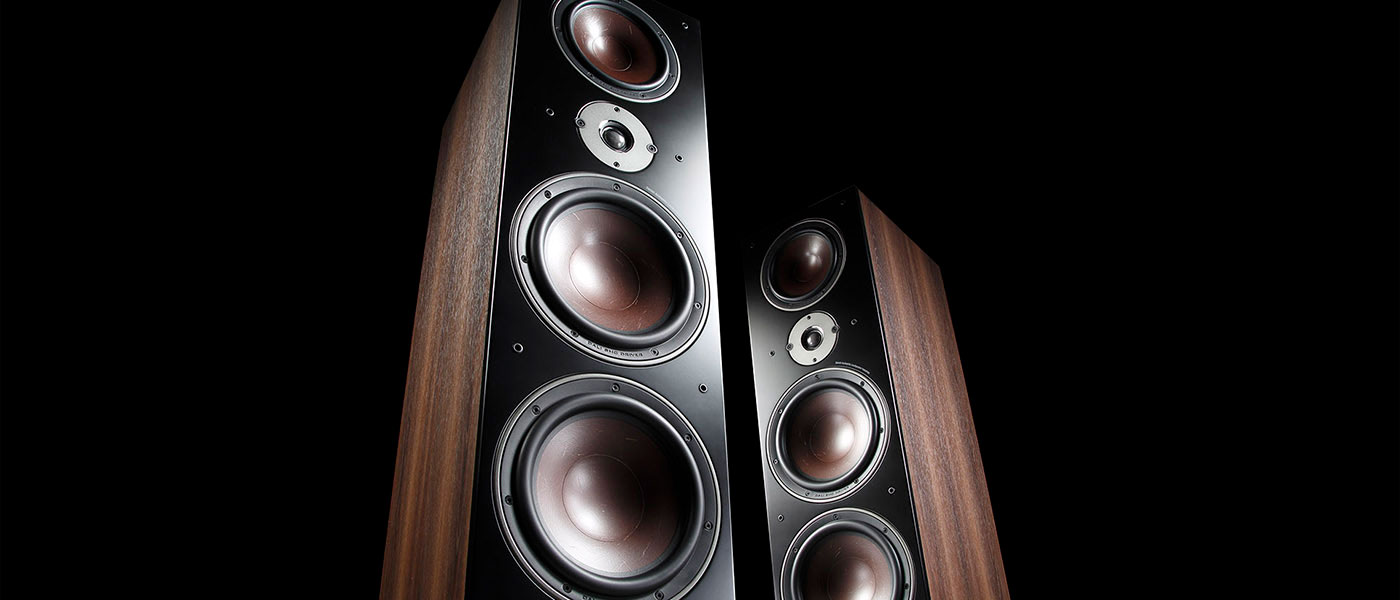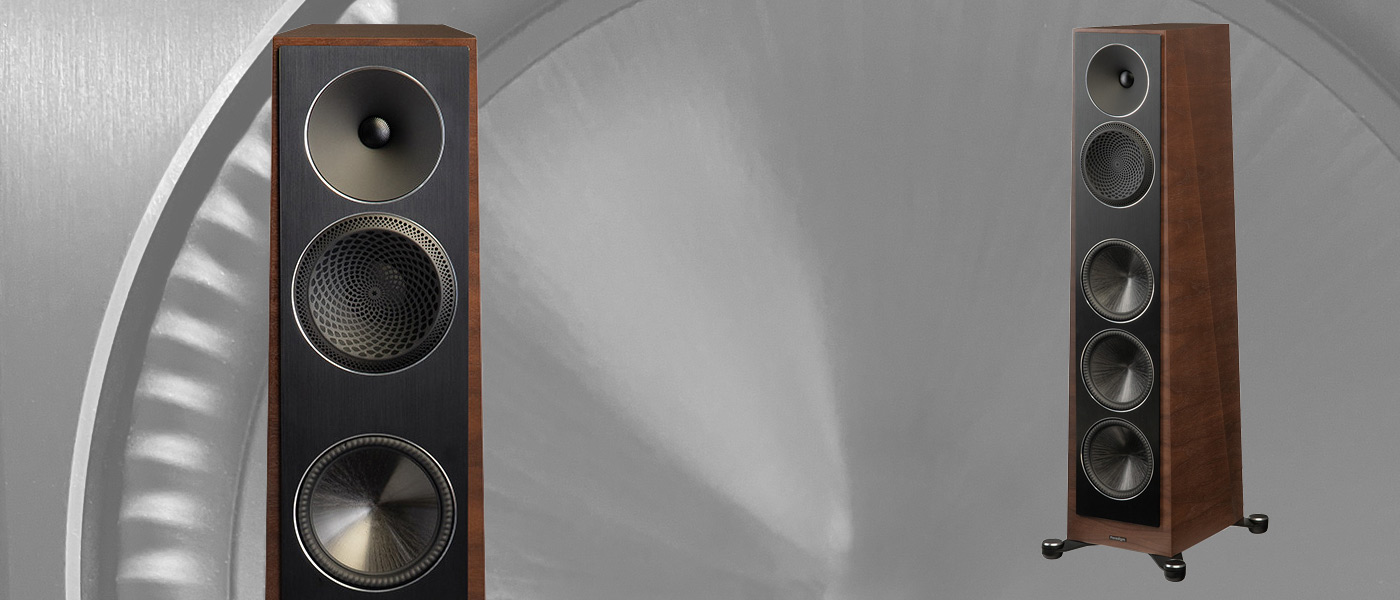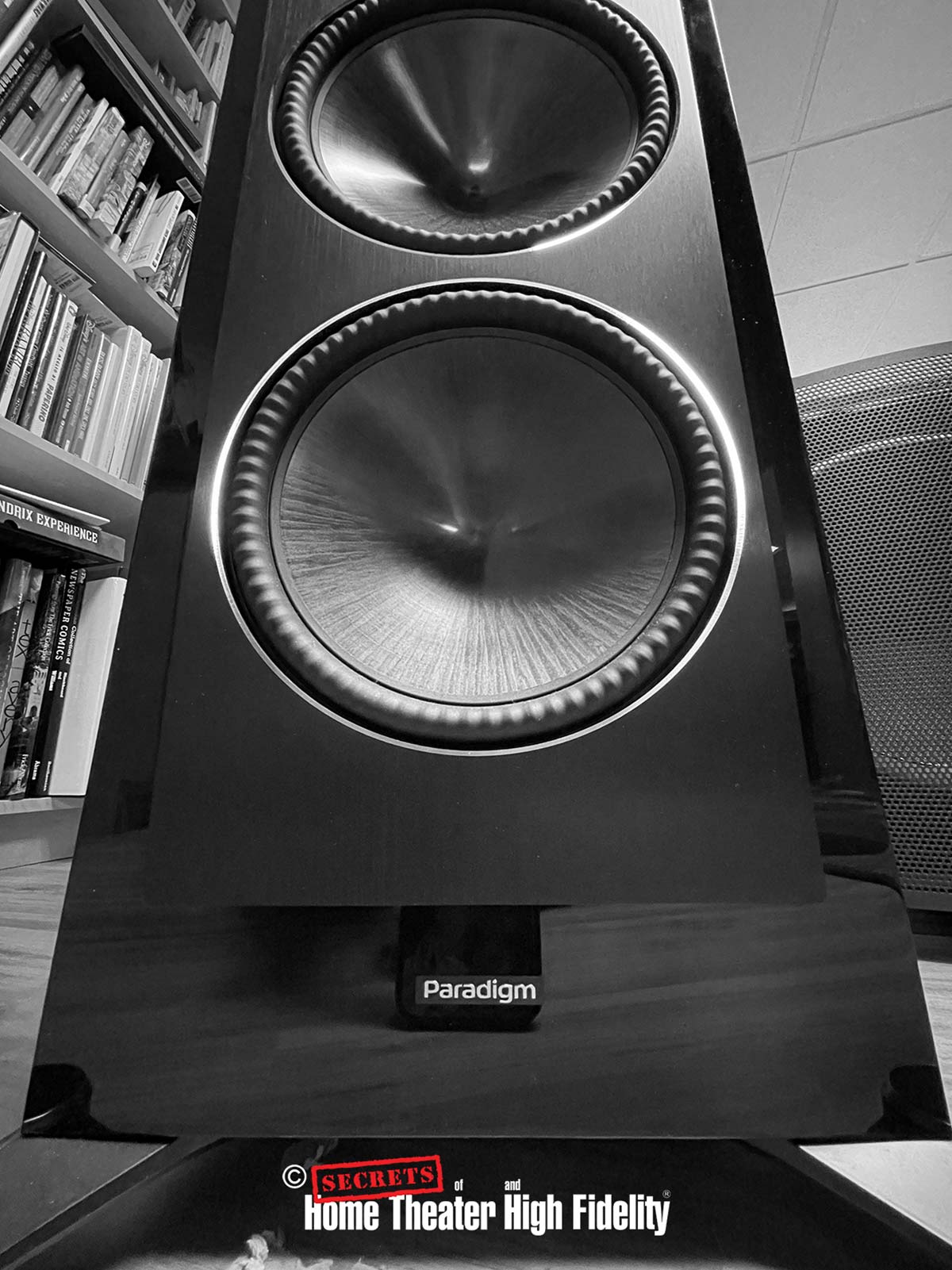As an outsider looking in, the new Paradigm Founder line of speakers seems to take some of the magic of the no-holds-barred Persona Series and melds it with a more straightforward, purposeful aesthetic and design focus, reminiscent of the company’s earlier days. While this may be considered a concrete manifestation of the return of Scott Bagby (one of Paradigm’s founders) and son John Bagby to helm Paradigm, it would be a mistake to write off the Founder line as just a simple throwback exercise. The Founder 120H loudspeakers that I have in for review are brimming with new features, a refined design language, and a very solid purpose.
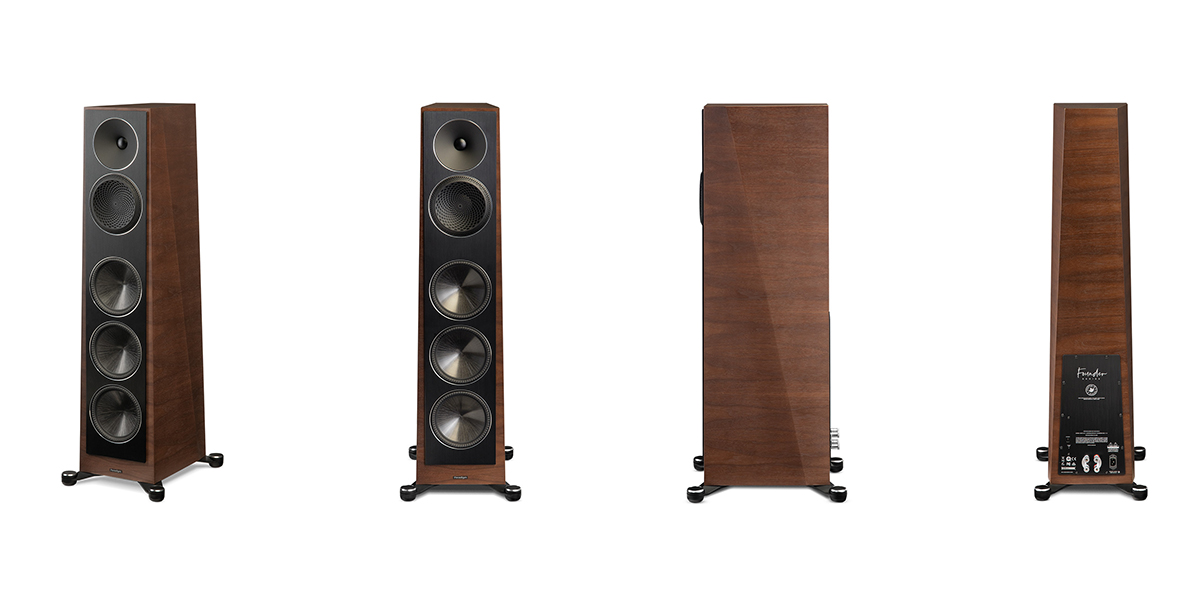
Paradigm Founder 120H Loudspeaker Rotation
PARADIGM FOUNDER 120H LOUDSPEAKER
- It’s a box, but it’s an elegant, refined-looking box.
- Tremendous bass capability with integrated ARC room correction from 300 Hz down.
- Sounds different from the Persona. Less exciting but more balanced overall.
- Imaging and soundstage are massive.
- Seamlessly bridges the best of Paradigm’s past with exciting future tech.
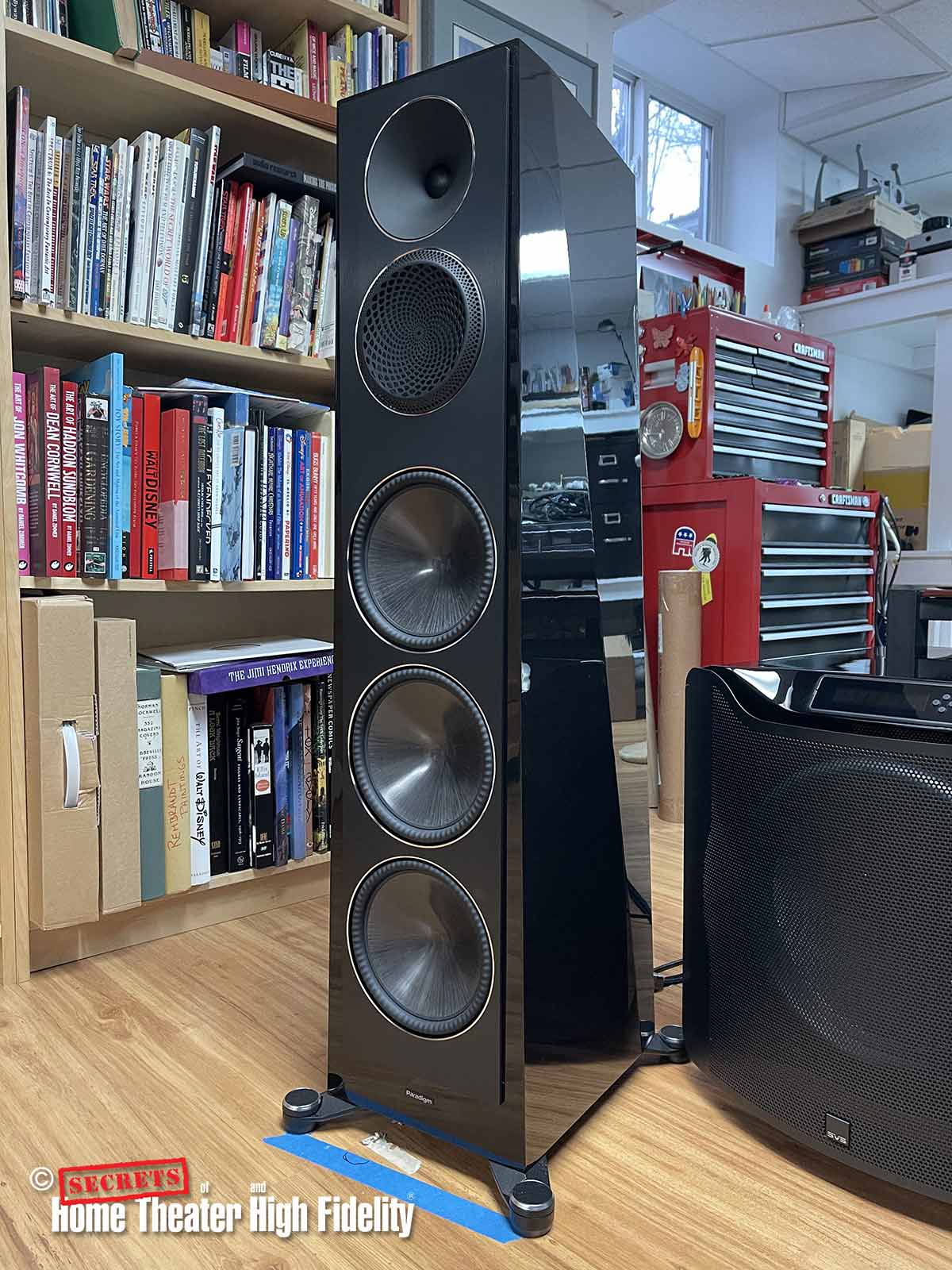
Paradigm Founder 120H Loudspeaker in Studio.
It really is all in that name, Founder. One of the enticements for Paradigm founder Scott Bagby’s return to the company’s helm was the chance to oversee the development of a statement-level loudspeaker line. And while the Persona series already existed as a no-holds-barred, gloves-off statement of Paradigm’s capabilities, Founder is more in keeping with the company’s long-standing ethos of a more affordable high-performance loudspeaker design. In an interview I conducted with both Scott and John Bagby late last year, both men made it very clear that Paradigm is a science-based company and that, regardless of the speaker line or price point, everything is done with an eye to quantifiably maximizing loudspeaker performance, within the budget constraints of a given product. With that in mind, it is clear to see that with Founder, the design team took some of the best ideas from Persona and adapted them for this project. Yet they also went in some completely different directions with the overall design of the Founder series, drawing a stark visual separation from the top-tier Persona and developing some new technologies specifically for this line which will no doubt trickle down to other things in the future.

Paradigm Founder 120H Loudspeaker Exploded View.
When I reviewed the Paradigm Persona 7F loudspeakers back in 2018, I specifically asked for that model over the 9H because it did not have the active bass section or the built-in ARC room correction. At the time, and for that caliber of a loudspeaker ($27,000.00 per pair), I was interested purely in its passive performance in my listening space. If I desired any room correction it had to come from a connected preamp. For this review, the top-of-the-range Founder 120H has the active bass section (via three 8-inch woofers powered by a 1000-watt RMS amplifier, per speaker) and ARC Genesis room correction from 300 Hz on down. This “hybrid-loudspeaker-with-DSP” concept strikes me as a much more intriguing proposition at the roughly $8,500.00 per pair price point of the 120H. And with on-board room correction ready to deal with the most difficult acoustic issues in a room (that’d be the bass), the Founders 120H stack up very well against some other well-regarded sub $10,000.00 per pair loudspeaker competition. At least they do on paper. Let’s see how they do in the real world!
Design:
5-driver, 3-way hybrid floor-standing loudspeaker with active bass, ported enclosure.
High-Frequency Driver:
Single 1″ (25mm) AL-MAC™ Ceramic Dome with Oblate Spheroid Waveguide (OSW™) and Perforated Phase-Aligning (PPA™) Tweeter Lens, ferro-fluid damped / cooled.
Mid-Range Driver:
Single 6” (152mm) AL-MAG™ Cone with Perforated Phase-Aligning (PPA™) Lens, SHOCKMOUNT™ Isolation Mounting System, and a 2” high-temp multi-layered voice coil with ventilated Apical™ former.
Low-Frequency Driver:
Triple 8″ (215mm) Ultra-HighExcursion CARBON-X™ Unibody Cone, Gen3 Active Ridge Technology (ART™) with Vertical Mounting System, Advanced SHOCK-MOUNT™ Isolation, and a 1.5” high-temp multi-layered voice coil with ventilated Apical™ former.
Frequency Response (Manufacturer, on-axis):
±2dB from 22 Hz – 23 kHz
Sensitivity:
95 dB (in-room) / 92 dB (anechoic).
Crossover Frequencies:
2nd order at 2.4 kHz (tweeter), 2nd order digital/analog @ 300 Hz (bass)
Onboard Amplification:
Three woofers are powered by a separate DSP-controlled 1000 W RMS amplifier (2,000 W Dynamic Peak).
Nominal Impedance:
Compatible with 8 ohms.
Suggested Amplifier Power:
15 – 400 Watts.
Maximum Input Power:
300 watts.
Dimensions (H x W x D):
45.4” x 13.9” x 17.4”
Weight:
92 lbs. (each).
Available Finishes:
Piano Black, Black Walnut, Midnight Cherry, Walnut.
Accessories:
Carpet spikes, Allen Wrench, power cords.
MSRP:
$8,500.00 (pair).
Website:
Company:
SECRETS Tags:
Floor Standing Speakers Reviews 2022, paradigm, founder, hybrid, active, loudspeaker, room correction
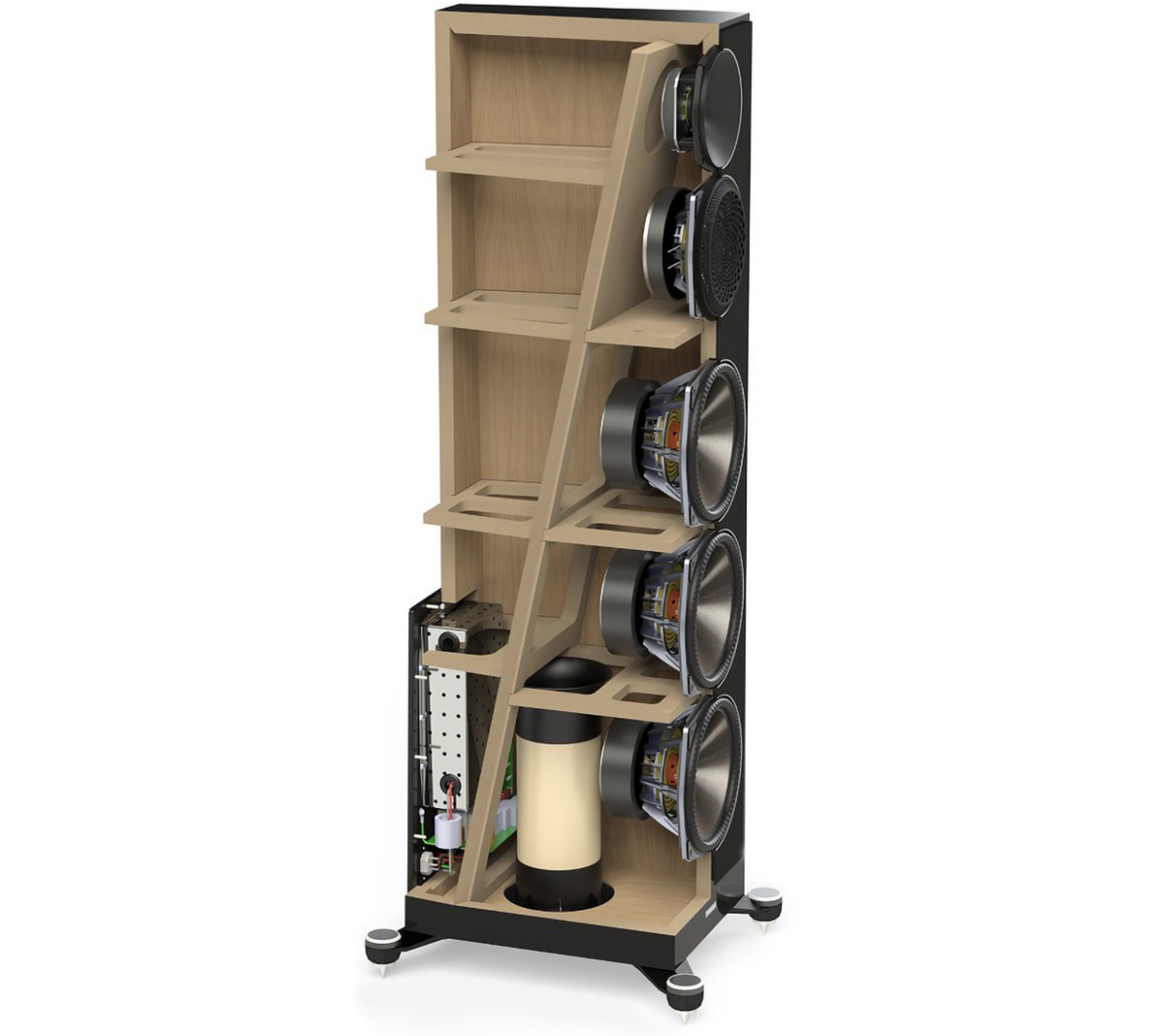
Paradigm Founder 120H Loudspeaker, Internal View.
Eschewing the more curved cabinets of its statement Persona line, the Paradigm Founder 120H (along with the rest of its kin in the series) are enrobed in a more artful, tapered box. It gives the impression of something you might find in a room filled with Mission-style furniture or Frank Llyod Wright décor. The eye immediately catches those long diagonal edges that bisect both sides of the cabinet. Beyond being aesthetically pleasing it also breaks up any symmetrical areas inside the enclosure to minimize internal standing waves. It also marks the positioning of a full-length diagonal vertical brace that intersects at various points with four short horizontal braces. This all results in a solid and very tightly braced enclosure that passes the knuckle-wrap test with flying colors and minimizes the chances of coloration to the sound.
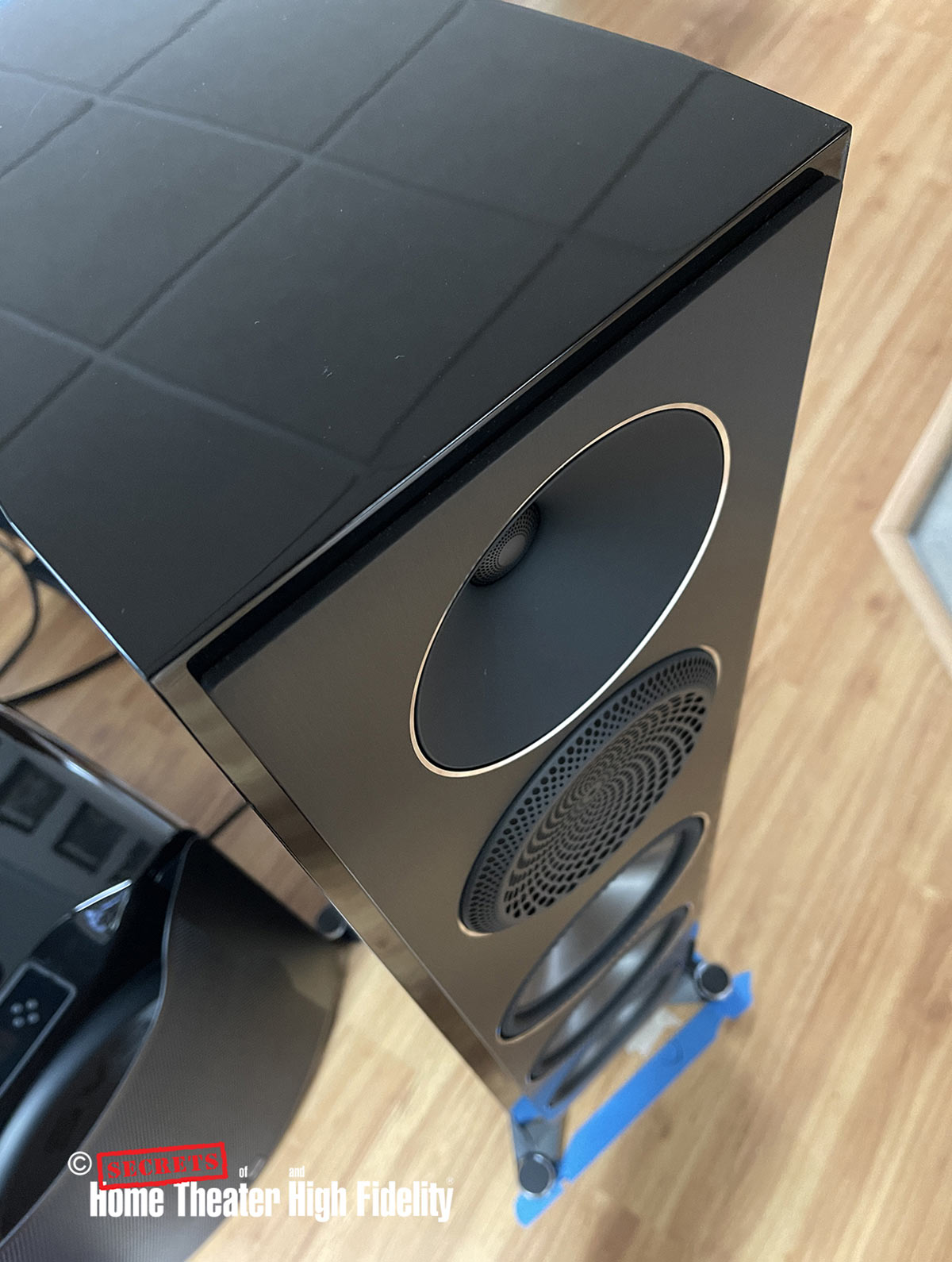
Paradigm Founder 120H Loudspeaker, Surface Close Up.
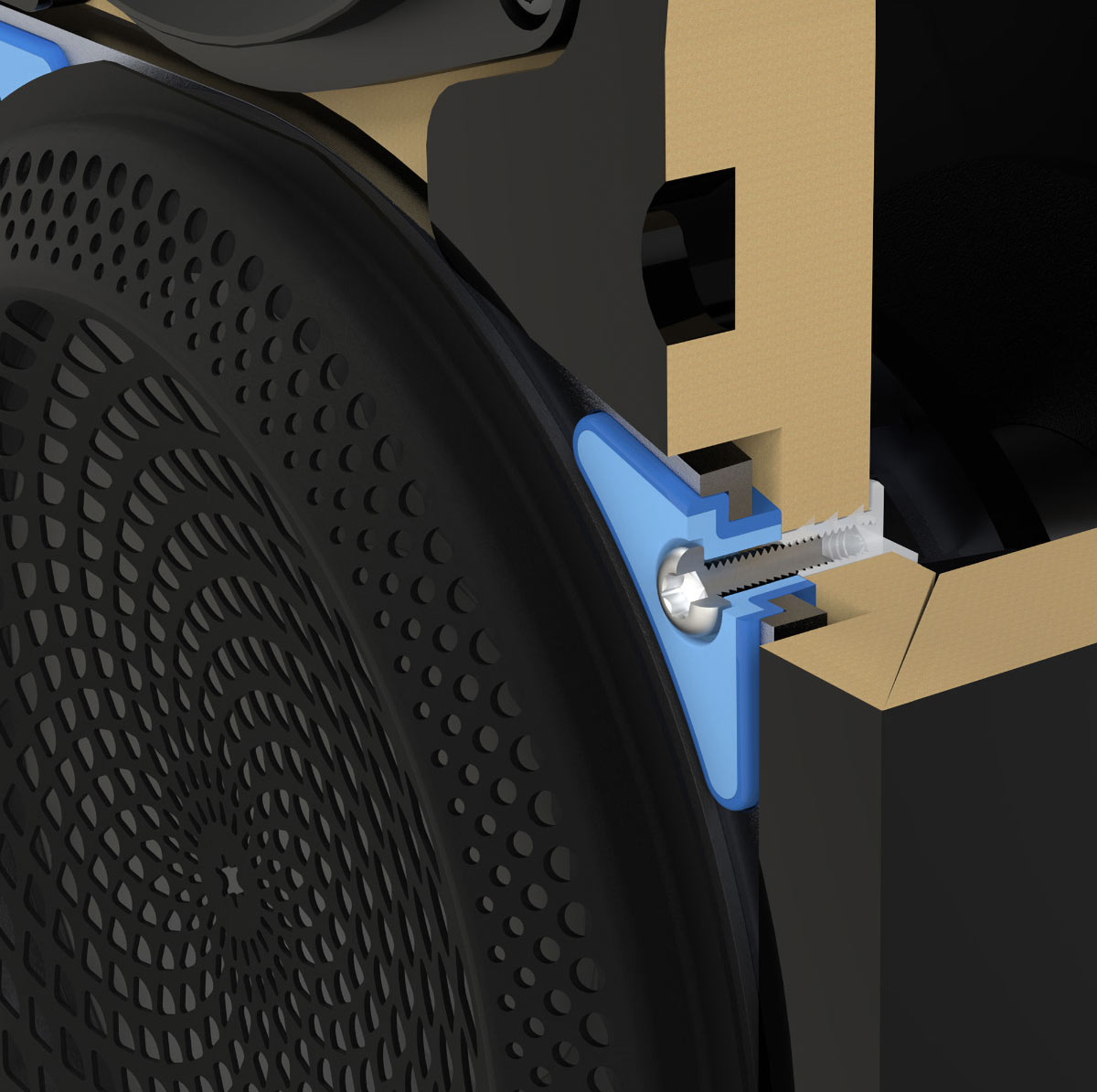
Paradigm Founder 120H Loudspeaker, Shock Mount Detail.
The face of each speaker features a thick plate of anodized aluminum that sits on the front baffle and visually appears to be flush with the drivers. Not only decorative in appearance, with sharp finished silver edging around each driver, but the aluminum also provides additional rigidity to the front baffle. The drivers themselves are not attached to the aluminum plate at all but are fastened to the cabinet proper with a somewhat unconventional method. Instead of the drivers being screwed directly into the cabinet and their frames being solidly in contact with the front baffle, each fastening point of the Founder 120H midrange and bass drivers has an elastomer suspension (a type of fancy rubber grommet) that effectively isolates the driver from transmitting any vibrations to the cabinet when the drivers are screwed into the embedded T-nuts. If you’ve ever built your own computer, some of the newer and more expensive case cooling fans use the same sort of technique to isolate a high RPM fan from transmitting its vibrations to the computer case when attached, thus avoiding unwanted noise.

Paradigm Founder 120H Loudspeaker, Waveguide Close Up.
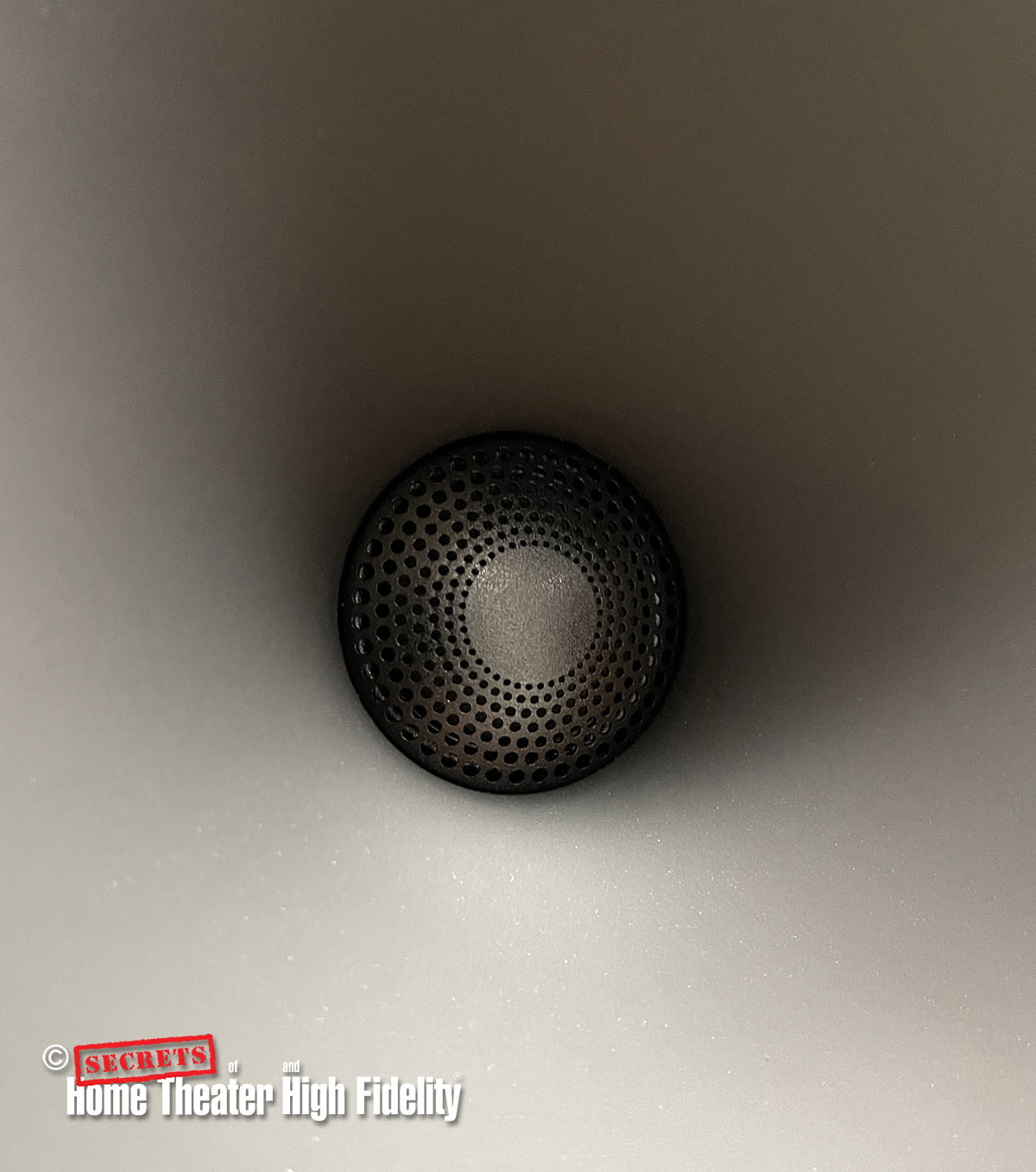
Paradigm Founder 120H Loudspeaker, Tweeter Close Up.
When taking a closer look at the Founder drivers the first thing that grabs your attention is the dramatic waveguide (almost looks like a horn) that houses a 1-inch tweeter. The waveguide’s dramatic depth allows Paradigm to control the tweeter’s horizontal dispersion more effectively, focusing more of the driver’s output to the listening area with less energy to be reflected off the sidewalls. The tweeter’s dome is composed of an unusual Aluminum-Magnesium-Ceramic composite to which Paradigm cites benefits of lightness of weight, high rigidity, and immunity from resonances. The tweeter is also covered with a perforated layer that the company calls a PPA (Perforated Phase-Aligning) Lens which purportedly helps all frequencies (in the driver’s operating range) to arrive at the listener’s ear at the same time.
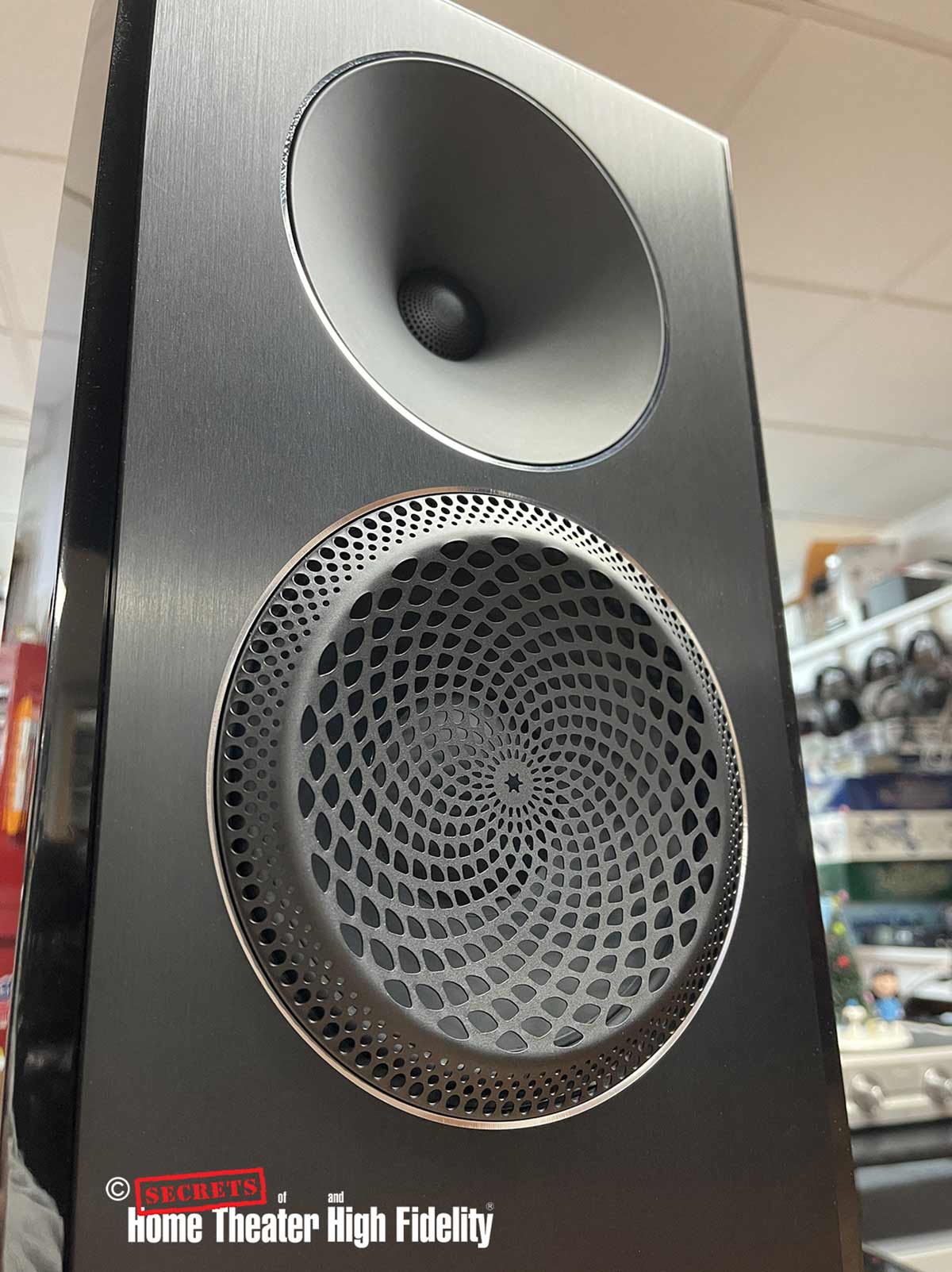
Paradigm Founder 120H Loudspeaker, Midrange Close Up.
The 6-inch midrange driver uses an Aluminum-Magnesium composite in its cone construction, along with a 2-inch voice coil. The driver also has a PPA Lens that covers its face, similar to what is seen in the corresponding drivers of the Persona Line.
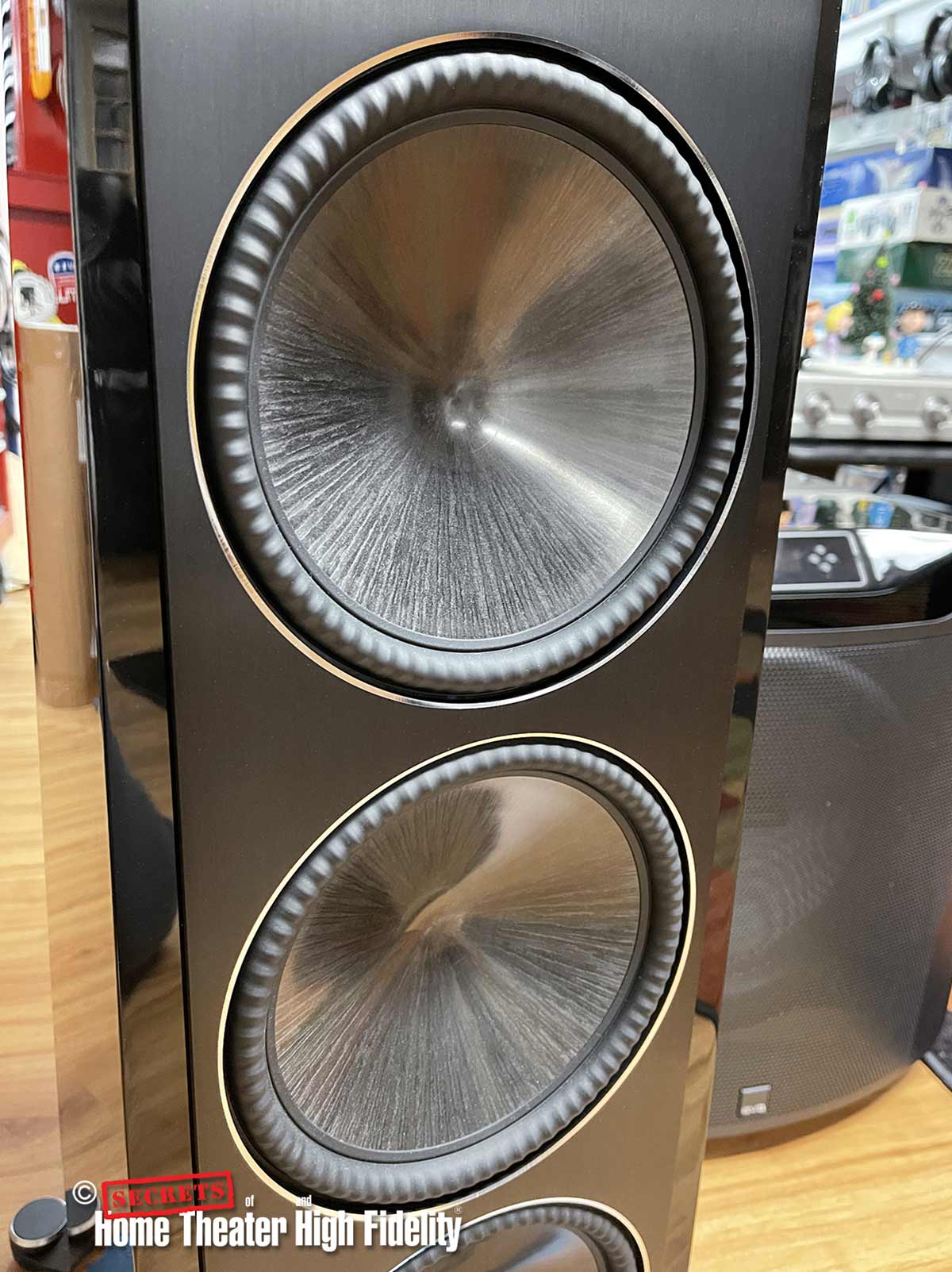
Paradigm Founder 120H Loudspeaker, Woofer Close Up.
The three bass drivers in the Founder 120H are 8-inch, high-excursion units using a new one-piece cone construction made from what Paradigm calls “Carbon-X” material (no that is not the stuff that gave The Powerpuff Girls their superpowers). The cones are secured to the driver frame with a large, scalloped ART (Active Ridge Technology) surround like those first seen on Paradigm’s larger subwoofer drivers. These bass drivers are powered by an internal 1000-watt RMS power amplifier (per speaker) that leverages a custom edition of ARC (Anthem Room Correction) Genesis. This edition of ARC will only measure and correct the bass frequencies of the 120H from 300Hz and down. As such, the speaker will take the incoming signal from your power amplifier and convert everything below 300Hz to digital to send to the internal bass amps for correction and amplification. Everything above 300Hz remains completely in the analog domain and is directed to the appropriate analog crossover elements and drivers. The enclosure also sports a 4-inch port, firing out of the bottom.

Paradigm Founder 120H Loudspeaker, Isolation Feet.
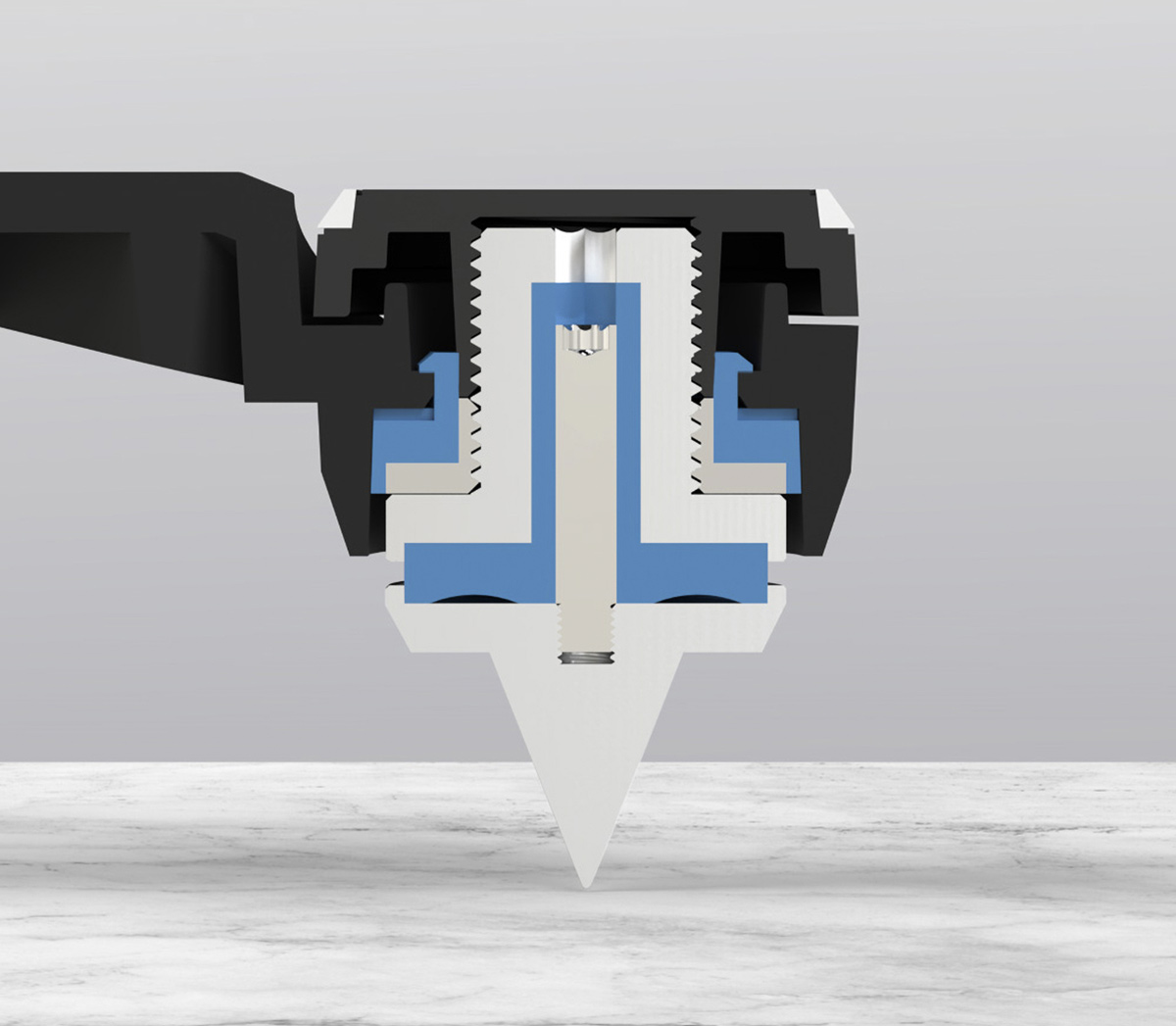
Paradigm Founder 120H Loudspeaker, Isolation Feet Cross Section.
The cabinet has four short outriggers with adjustable feet that feature dual points of isolation to decouple the loudspeaker from the floor. The feet are adjustable from the top, simply remove the cap and use the included key to lower or raise the height. The feet have a rubber compound on the bottom for hard flooring but also come with screw-on carpet spikes if the destination surface is plush.
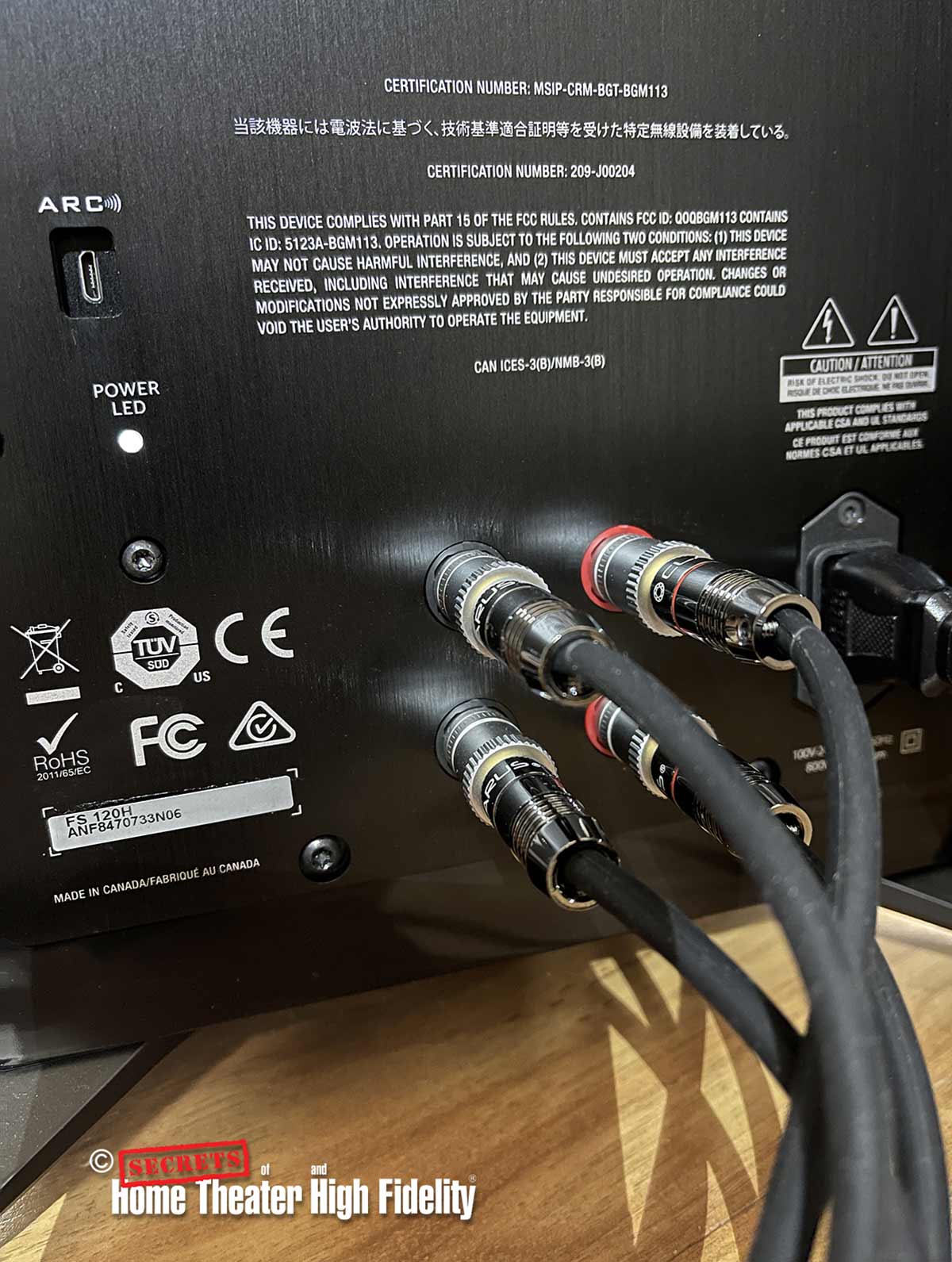
Paradigm Founder 120H Loudspeaker, Rear Panel.
The back of the Paradigm Founder 120H features two sets of binding posts with removable metal straps for bi-wiring. Each speaker has a mini-USB connector on the back for connecting to a computer for initial setup and running ARC (more on that later), a 3-prong IEC power cable connector, and a status LED.
The speakers come with an ARC Genesis measuring kit which includes a calibrated microphone, mic stand, and USB cable. The ARC software can be downloaded from the Anthem/ARC website and installed on your computer.
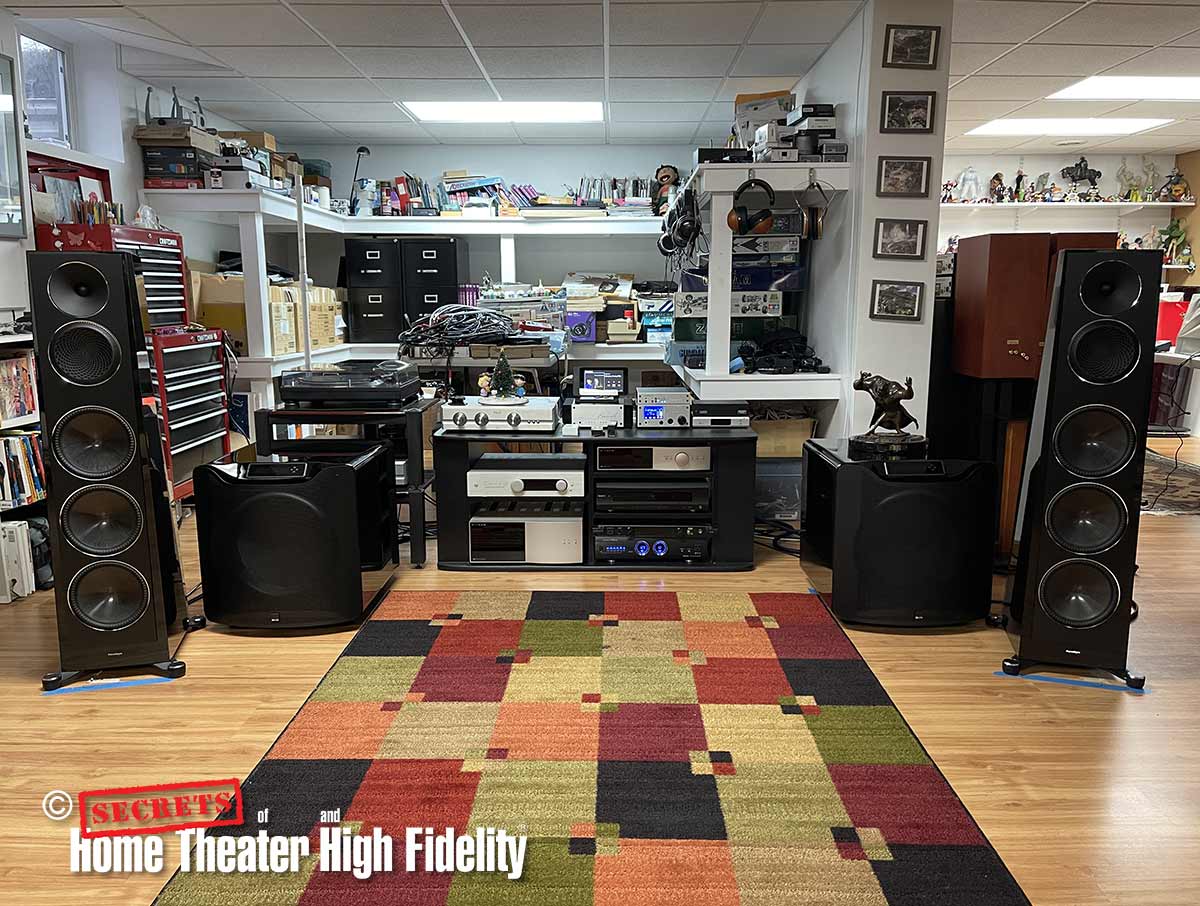
Paradigm Founder 120H Loudspeaker Listening Setup.
The Paradigm Founder 120H Loudspeakers were set up in my studio listening space, well away from the front wall. They were spaced approximately 9 feet apart with the main listening position being 10 feet away from the center point between the speakers. The speakers required about 15 degrees of toe-in to get the imaging sounding agreeable to my ears in this room. As my studio has a Pergo-style laminate floor, the Paradigm’s integrated feet with rubber bases (sans spike attachments) were perfect. They allowed the speakers to stay firmly planted when final positioning was determined and left enough room for the down-firing port to breathe.
The equipment used in this review consisted of my KAB modified Technics SL1200 MK 6, a Technics SL1500C along with an Audio-Technica OC9XML MC cartridge, and a Sumiko Celebration 40 MC cartridge (review coming soon), respectively. The rest of my audio chain consisted of the Bryston BP2-20 phono preamplifier, Benchmark Media HPA4 preamplifier, AHB2 power amplifier, and DAC3 B along with a DIY Raspberry Pi4 based ROON endpoint. Interconnect and speaker cables were from both Blue Jeans Cables, Clarus Cables, and Benchmark.
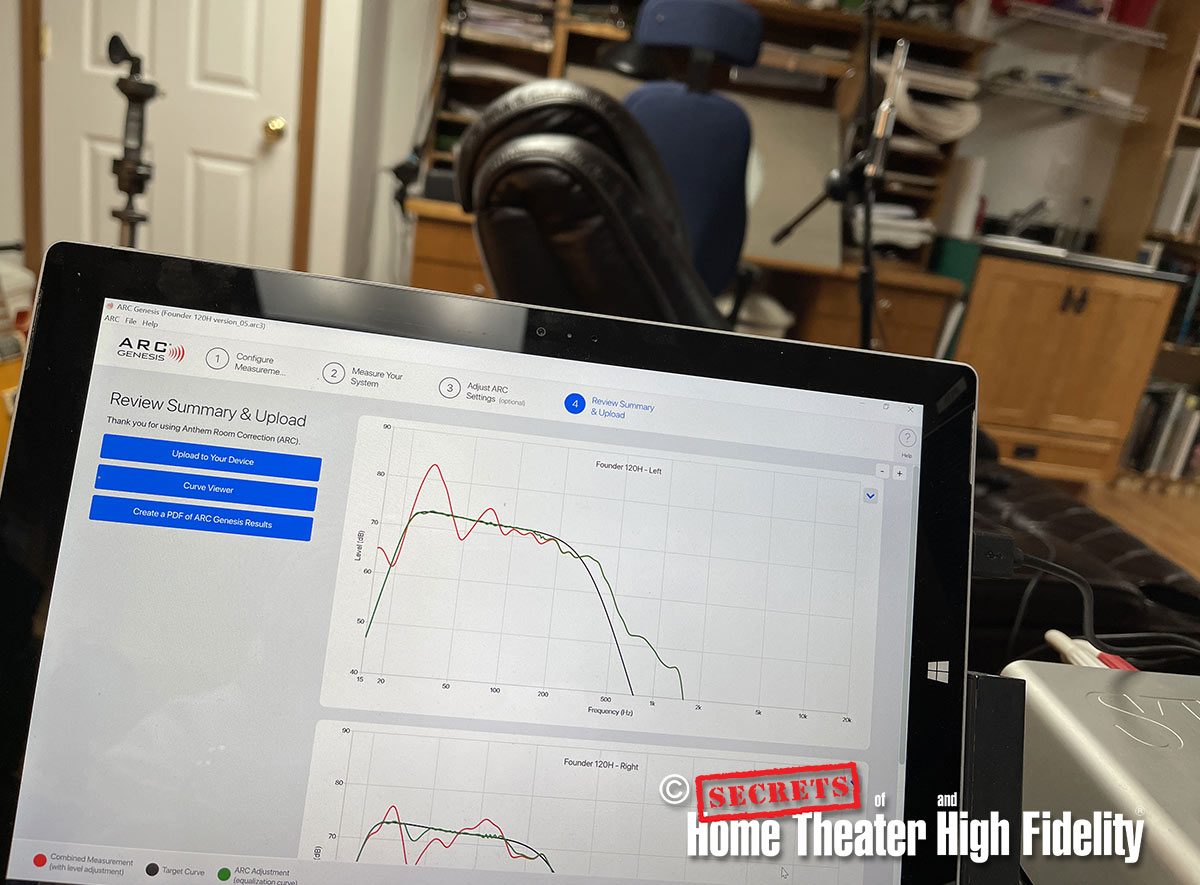
Paradigm Founder 120H Loudspeaker, ARC Measurement.
One thing to note with the initial setup of these hybrid loudspeakers is that I needed to connect one of them to my laptop that I was going to use to run ARC Genesis and designate that speaker as the master. In my case, this was the right speaker. Once that was done the master would communicate with the slave (left speaker) via Bluetooth to tell it when to run ARC test tones and upload its calibration information after measurement, etc. This is a very elegant programming solution as it means I only need to run one USB cable to one speaker to get all the setup and calibration work done.
Once the Founder 120H speakers had been set up and ARC Genesis room correction performed and dialed in, it was time to sit down and see what these intriguing speakers were capable of.
First things first, these speakers throw out a huge image. They sound big, detailed, and effortless! They are very reminiscent of the JBL 4367 loudspeakers that I reviewed a while back. The Founder 120H seems to have that same deep dynamic capacity where they do not fluster easily, if at all when pushed. Much of that, in the Paradigm’s case, is thanks to that powered bass section. Taking the bass reproduction heavy lifting away from your power amplifier leaves it free to focus on the less demanding midrange and tweeter and inherently produces less overall distortion. This made the 120H a perfect match for my ultralow distortion Benchmark Media electronics. My AHB2 power amp had no issue driving the Paradigms to ridiculous levels without duress. The output just kept scaling louder and remained as clean and clear as could be.
At more down-to-earth levels it became pretty evident that the 120H are in fact well overendowed in the bass department. As I was setting up the speakers and before loading up an ARC profile, it was easy to hear the pair of triple woofers were having no trouble exciting low and upper-bass room modes, and this is with the speakers placed well into the room. I could only imagine the avalanche of bass I might have heard if I had them closer to a wall. To me, this means that these speakers need ARC, by design. It’s always much easier/better to turn down the bass levels if you can than it is to boost them. This results in more headroom and lower distortion in the lower octaves. When calibrated, the Paradigm Founder 120H produces some of the best quality bass that I have ever heard from a tower loudspeaker. Once ARC Genesis had done its thing, the immediacy, the detail, and the sheer impact of what I was hearing from the big stuff like kick drums, timpani, organ, acoustic bass, and electronic bass was exceedingly good. Very much like having a well-integrated subwoofer, or two, in the system. But even on the less obvious stuff like piano, some woodwinds, and acoustic guitar all benefitted from the additional body of that now optimized bass section.
I’ve read comments from some readers about finding the treble of the Paradigm Persona loudspeakers to be a little too much for their tastes. And while I thoroughly enjoyed the Persona 7F when I had it here for review, it’s a very different sounding animal from the 120H. More lively and exciting if you will. The Founder 120H is a little smoother and more laid-back sounding in the upper registers with vocals being a touch more forward through the midrange. Like I mentioned earlier, it’s a very effortless and easy to listen-to set of speakers that draws you in with the size and depth of the image it puts out and keeps you hooked with the sheer dynamics and natural tonal quality of whatever it is playing back.
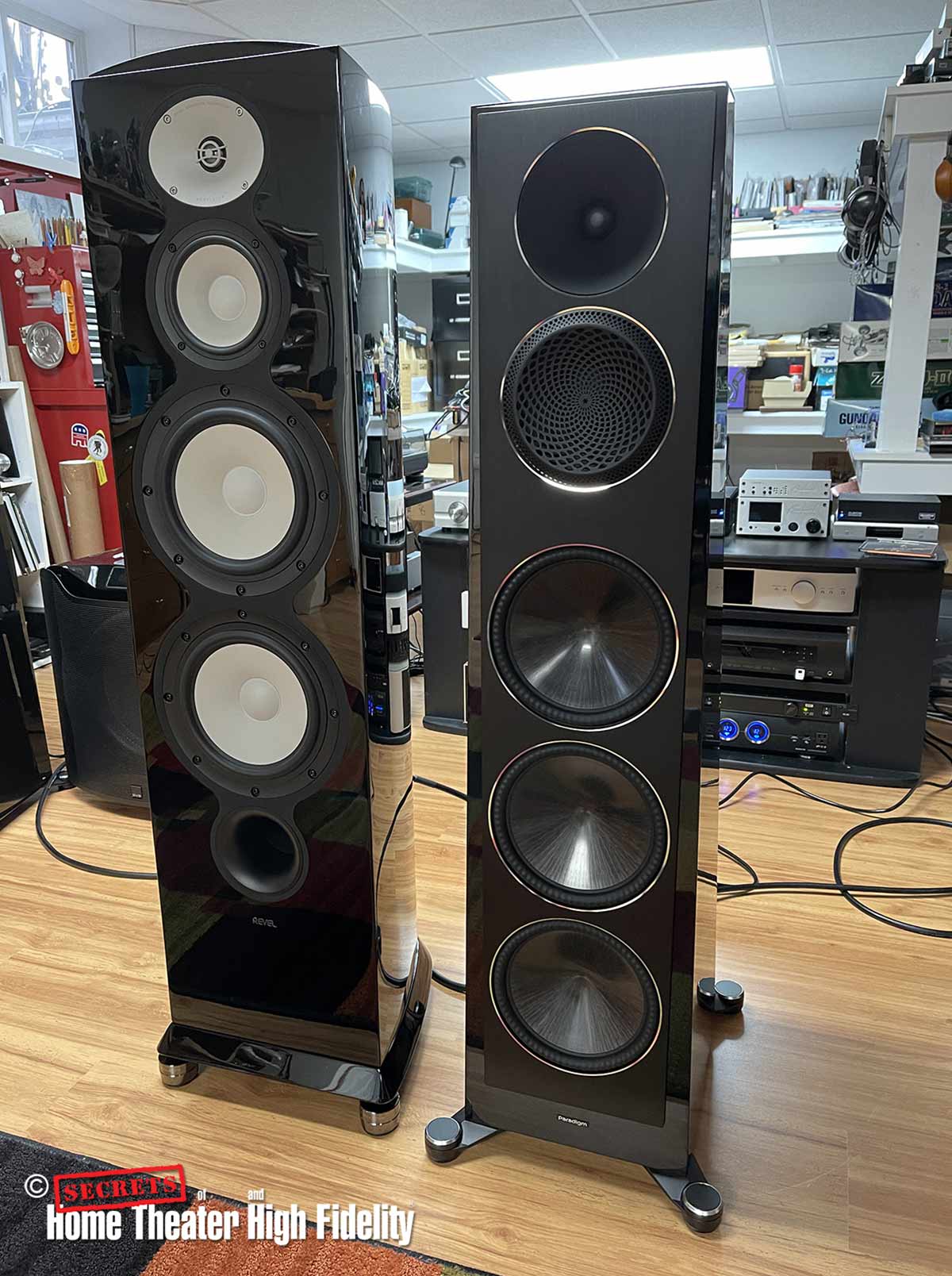
Paradigm – Revel Mono-Music Comparison.
As a little experiment, I lined up one of the Revel F228Be loudspeakers that I have here next to a single Founder 120H (uncalibrated) in the middle of my room, as far from any walls as I could get them. The F228Be is a good candidate to compare as it is in a similar class as the 120H both in price and performance although it is a fully passive design. After assigning them to different inputs and level matching the output of both speakers, I played some specially selected looped mono tracks through them (thank you, Dr. Rich). The tracks vary in content from classical to pop to jazz to male and female vocals with accompaniment. They were specially chosen because the audio spectrograms of the looped segments come close to resembling pink noise. Please refer to this article on Dr. Sean Olive’s blog for more background on this.
With this arrangement, I was able to immediately switch between either speaker via remote, so this allowed me to get an instant tonal comparison of the Paradigm against a known standard (the Revel). After cycling through each of the tracks on both speakers some takeaways became clear. The Founder 120H has an overall fuller and more rounded sound than the F228Be. It makes the Revel seem leaner sounding by comparison, although in practice it isn’t. The 120H just throws out a bigger image where the Revel projects sound in a tighter, more narrowly focused spread. Bass output and reach on the Founder 120H is superior although, uncalibrated, it occasionally gave the upper bass a little over prominence in a couple of tracks. In real-world use, ARC takes care of that. The tonal balance on both speakers is appealing with the 120H having a slightly more forward presentation of both male and female vocals. The Revels have a slightly more refined-sounding treble response, not by a lot but it was noticeable in this scenario. There are no audible gaps in the tonal range of either loudspeaker. Both transition from bass to mids to treble seamlessly and there were no issues with perceived transparency or detail from either.
Turning to regular music, the following are a few notable selections that I felt showed off the Paradigm Founder 120H during our time together:

Samantha Fish “Faster”, Rounder Records, 2021, 16/44.1 FLAC via Qobuz.
Samantha Fish is a top-notch guitar slinger with vocal chops to match. Her latest release is a great-sounding electric blues album that just demands to be turned up, by several notches, and these Paradigm speakers seem only happy to oblige. The raucous title track “Faster” sounded positively nasty (in a good way) with the speaker volume cranked up accordingly. Fish’s distorted guitar had gobs of weight and punch to it in the rhythm tracks with her piercing solo track overlayed, just spitting out raunchy venomous notes. Her vocals were pegged dead center of the soundstage with a depth and character that matched the guitar playing. Glorious stuff played loud. Switching to something a little slower-paced and with more of a pop sensibility, “Hypnotic” has a great pulsing groove to it and showcases a bit more of Fish’s singing ability. Her voice mutates at various points from light and wispy to full-throated to savage with the Paradigms ably revealing all the details of those changes while giving her voice a solid sense of presence. There are also several synthesized instruments and sound effects that ping-pong from points both inside and outside the speaker boundaries that add to the illusion of huge acoustic space. And then, quicker than Jekyll changing to Hyde, Samantha Fish launches into an absolutely feral guitar solo that drips with distortion. The Founders 120H demonstrates a huge capacity to play loud, deep, and clean without a ton of effort.
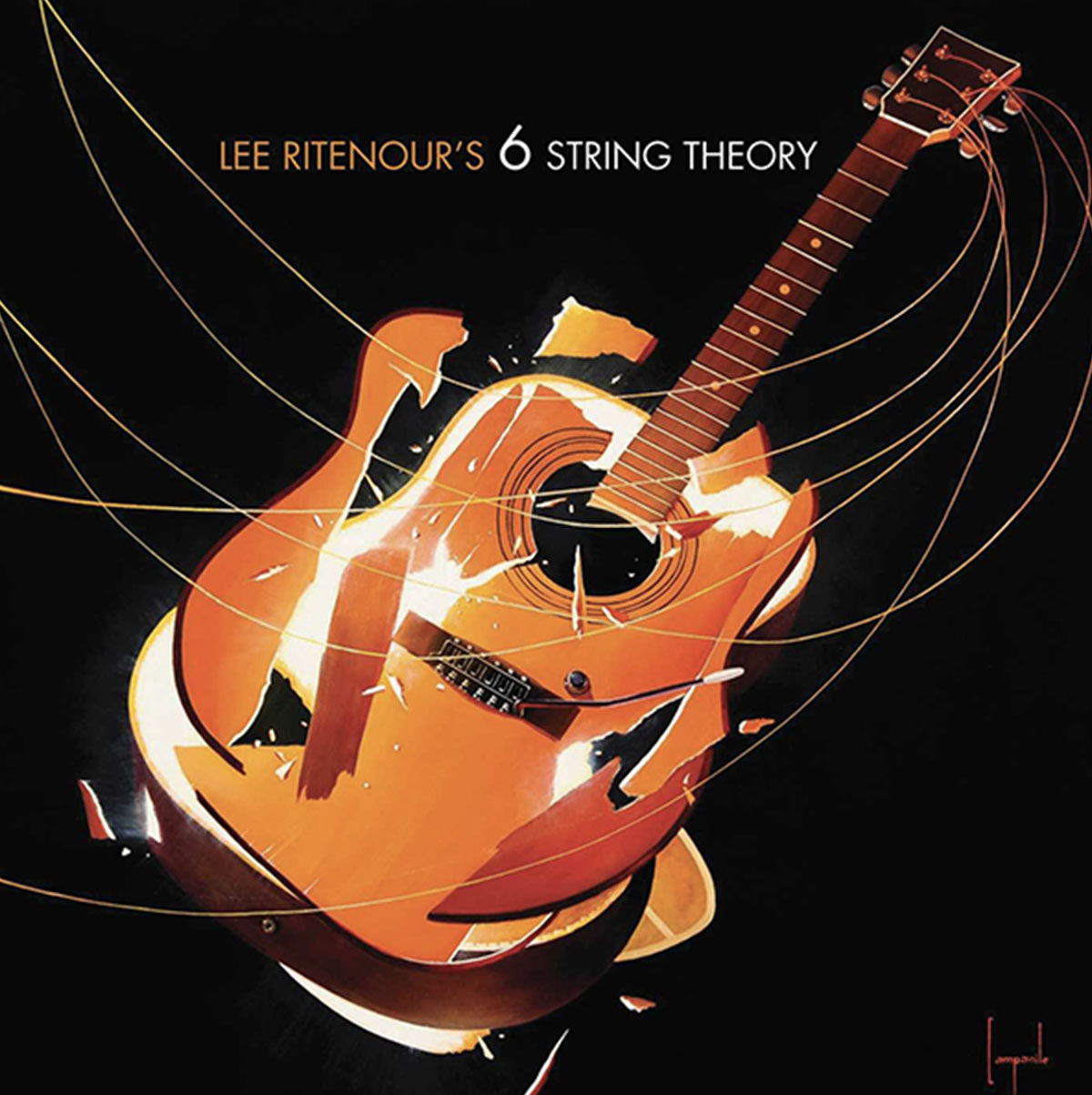
Lee Ritenour “6 String Theory”, 2020, Concord, 16/44.1 FLAC via Qobuz.
An excellent recording of Ritenour demonstrating his prodigious skills on the guitar in various genres of music and featuring some talented guests along the way. Starting with “Am I Wrong” I immediately heard the tight and seemingly total control of the bass that the Founders 120H possessed. The opening kick drum dug deep and had a palpably solid impact to its sound that I could feel from my chair. It’s the same sound and feeling I’d get if I was using a subwoofer except with perfect integration with the mains. The walking electric bass line also had a tightness and clarity to it that was easy to hear while not getting overwhelmed by that nice kick drum. The three guitars of Lee Ritenour and guests Keb’Mo’ and Taj Mahal were easily discernible and rendered by the Founders with precision in the soundscape. The image that these speakers throw is wide and deep and yet little details like those heard in Taj Mahal’s handling of the resonator guitar and the harmonica are crisp and detailed with a nice zing on the edges of his notes. Both Keb’Mo’s and Taj Mahal’s vocals were nice and alive sounding with every little bit of their distinctive character coming through. Quickly moving from a funky blues to a liquid jazzy vibe, “L.P. (For Les Paul)” demonstrates a velvety and fluid barrage of notes and tone courtesy of Ritenour, the late, great Pat Martino along with Joey DeFrancesco on organ. These speakers put me at the best table in a small, smoky (I know, no one smokes anymore but work with me here) jazz club. The illusion was very convincing with the tweeter in that waveguide and that big midrange driver just nailing all those details in their respective ranges, all with effortless efficiency.
Combined with the magic of well-controlled, all-encompassing bass from those triple 8-inch bass drivers that give the music foundation and scope. The musical sum is a well-integrated presentation that I sometimes felt I could reach out and touch. I daresay the Founders 120H gives you a very large slice of what the Revel F328Be does for a lot less out of pocket. Perhaps not with every last degree of refinement in the midrange and tweeter as the Revels but a darn sight close. The album ends with a classical piece “Caprices, Op. 20, No 2 and 7” featuring just 2 acoustic guitars. The Founders captured all the tone and string detail that I was hoping for but also framed that over the lovely tone and resonances of those hollow guitar bodies. The end results gave the instruments more meat and dimension than expected, and I loved that.

Zubin Mehta and The Los Angeles Philharmonic Orchestra “Star Wars & Close Encounters of the Third Kind”, London Records, 1978, LP.
Switching to a little vinyl, I recently picked up a spotless version of this great LP at a thrift shop and it did not disappoint on the Paradigms. Sticking to the Star Wars soundtrack side of the album, the iconic “Main Title” sequence sounded appropriately bold and sweeping with a nice wide soundstage and the 120H’s bass capabilities were fully being exploited with the orchestra and Zubin Mehta’s unique reading of the score. However, the more delicate and subtle parts of the theme were not left wanting either, the Paradigm’s tweeter and midrange got just the right brassy shimmer to the sound of the horns. The sparkling sound of the triangles and other higher octave percussion instruments also were wonderfully replayed. In “Princess Leia’s Theme”, the delicacy of the flute and backing woodwinds was quite delightful when played back at a decent volume. The harp plucks also sounded very smooth yet well-defined with the upper bass performance of the speakers giving additional body to that instrument’s sound. It certainly did not sound thin. The solo violin that accompanied the harp was also nicely rendered without getting overly thin in tone.

Friend ‘n Fellow “Covered”, Doctor Heart Music, 2005, 16/44.1 FLAC via Qobuz.
This album simply consists of the wonderful vocals of Constanze Friend and the acoustic guitar playing of Thomas Fellow. And as the title of the album suggests, the duo are covering various popular tunes from various genres and eras of music in their own inimitable style. The Bill Withers penned song “Grandma’s Hands” consists only of Friend’s vocals without any other accompaniment or embellishments and it’s a powerful, moving expression of what a single human voice can get across. Here the Founders 120H triple bass drivers take a little break as the tweeter and midrange work to beautifully render her vocals precisely in space and add just the right amount of weight as she sings lower in her range. Every little breath and inflection are clearly heard in the playback and it’s a clear indication of how well the Founder’s two upper drivers are working when mostly on their own. My other favorite on this album is the classic Johnny Mercer/Hoagie Carmichael song “Skylark.” Here the duo performs one of the nicest renditions of this song that I’ve come across with Friend’s beautifully soulful vocals fully and tangibly rendered in front of me. And Fellow’s acoustic guitar is scaled up big and imaged very wide by the Paradigms with the sounds of the lower register notes practically filling my room, while being punctuated with the clean, sparkling higher notes all around. It was like listening to acoustic fireworks, very dazzling stuff.
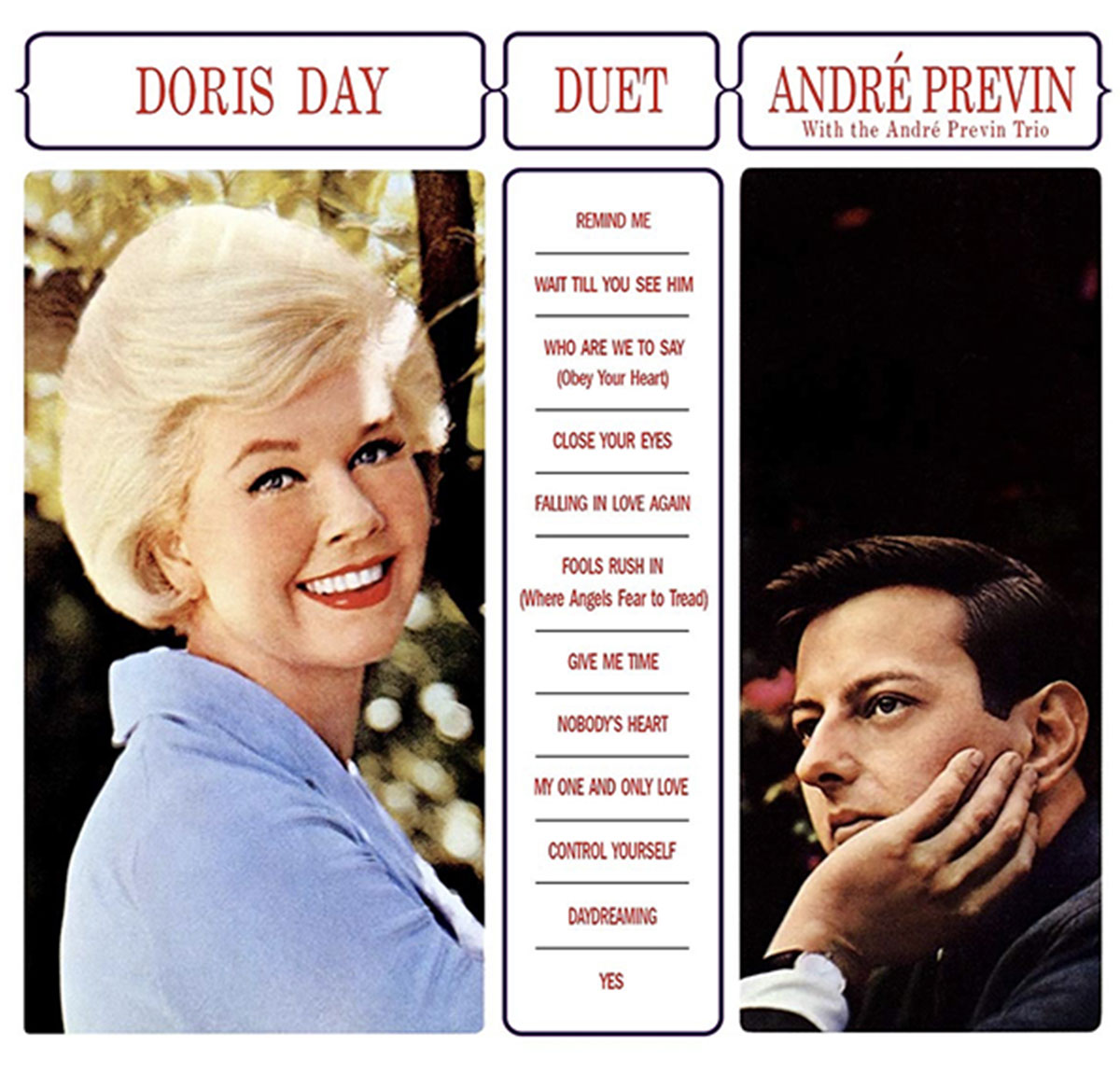
Doris Day and Andre Previn “Duet”, Columbia, 1962, 16/44.1 via Qobuz.
A beautiful and intimate jazz/blues recording that is a startling reminder of what Doris Day was vocally capable of and of Andre Previn’s chops on a piano. Even though the piano was mixed hard to the left and Day’s vocals are hard to the right the Founders 120H expand the soundstage such that the music still has an enveloping sense of atmosphere. Acoustic bass and drums, when present, are mixed towards the center and add significant foundation to round everything out. “Close Your Eyes” starts the album with a nice, meaty acoustic bass line opening, creating a tight solid stage for Day’s slightly smokey but unmistakably charming vocals to come in from the right speaker. The 120H reproduces her voice with such body and texture that it’s uncannily real sounding, even being mixed so hard to the right. This is not the sort of music that I associate with Doris Day, yet she has full command of the material with the Paradigms nicely and smoothly reproducing her extended vocal range. Nothing sounds off or unnatural at any point. Previn’s piano comes in on the right as she sings and then goes into a solo as she takes a break. The piano sounds playful and upbeat (almost boogie-woogie) with a great ring to the notes. The drum kit is active now too at center-left with a nice crisp snap to the drum skins and great shimmer to the cymbals. “Control Yourself” is another classic tune that, with these speakers, sounds dynamic and alive. Even with the old-school mixing quirks, the illusion of sitting in a live club and listening in on this performance is strong. “My One and Only Love” is the other standout performance here with Doris Day’s voice being so up close and personal sounding. I can hear how she is naturally and artfully forming every word through the Paradigms, those little details are coming across so strongly. Previn’s piano playing here just flows and sounds so, so smooth with a deft touch. Kudos to Paradigm for making these speakers capable of reproducing music so effortlessly.
Measurements by Carlo Lo Raso, Technical Analysis by Carlo Lo Raso and David A. Rich.
Bench tests were performed with a Cross Spectrum Labs calibrated UMIK-1 USB microphone connected to my Surface 3 PRO tablet and using Room EQ Wizard acoustic measurement software. On and off-axis measurements were taken with the mic at 1-meter from the center point between the tweeter and the midrange drivers. Unlike measurements taken outdoors or in an anechoic chamber that measure a speaker in isolation (and assess straight-line engineering), in-room measurements give a sense of how a speaker behaves in the actual environment that it’s used. Both types of measurements are valuable, I just find in-room measurements interesting as they help shed light on what I am hearing and why. That, and I don’t own an anechoic chamber or a Klippel automated analyzer!
Impedance measurements were taken using the Dayton Audio DATS v3 loudspeaker tester and software.
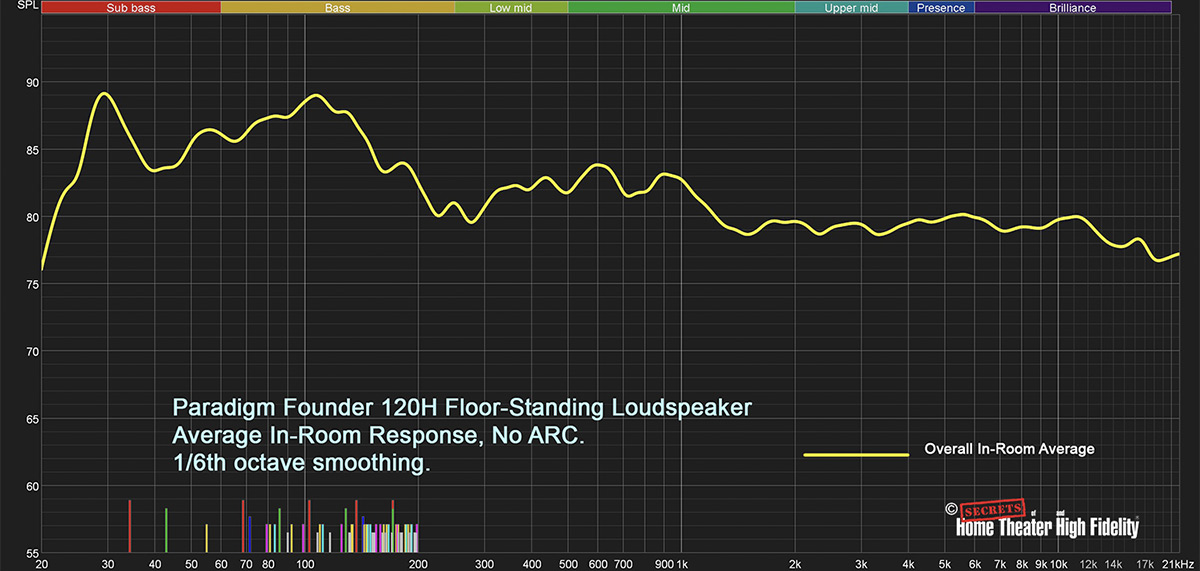
Paradigm Founder 120H, Averaged In-Room Response, No ARC.
This in-room measurement of the Paradigm Founder 120H is an 18-point spatial average. A 9-point measurement was made for the right speaker and then repeated for the left speaker. Averaging both speakers is an approach that others have been using and publishing. Using data from both speakers reduces the modal response of the room by averaging the differences in the response of the two speakers from room asymmetries. The technique cannot eliminate them however and, as such, the response below 300Hz remains room dominated. This particular measurement is without any room correction loaded into the speaker’s DSP. The results show a bit of a boost in response between 350 Hz and 1 kHz. After this, the response remains consistent up until 12 kHz where we begin to see a 4dB decline out to 20 kHz. Below 350 Hz, we see the bass section of the speaker putting out a noticeably higher level of energy than the rest of the spectrum peaking at both 110 Hz (room mode) and 28 Hz before steeply rolling off.
David Rich notes:
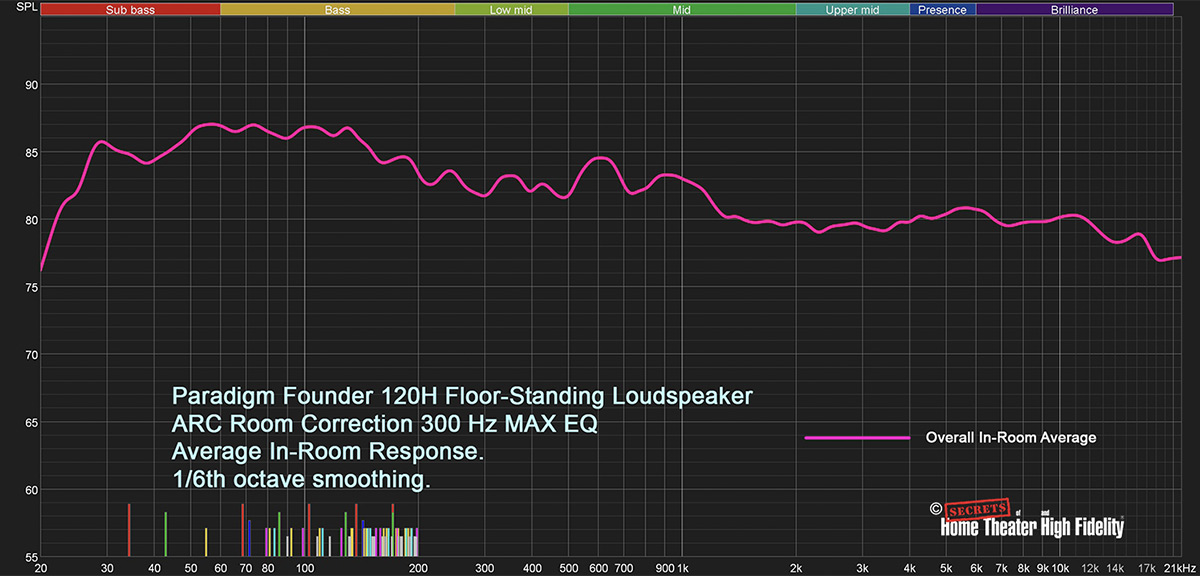
Paradigm Founder 120H, Averaged In-Room Response with ARC.
This graph shows an averaged in-room response of the Paradigm Founder 120H, performed in the same manner, but using the built-in ARC Genesis system to auto-correct room issues from 300 Hz and below. Everything above 300 Hz is untouched. We see that the excessive natural bass energy of all the 8-inch drivers has been dealt with resulting in a fairly desirable house curve with a touch of remaining midrange emphasis from 550 Hz to 1200 Hz. This emphasis may be a room effect since it is not seen in the quasi-anechoic curve below.
David Rich notes: The curve shows the classic monotonic in-room response for a speaker with a flat on-axis response and well-controlled radiation patterns. Note the depression at 1kHz – 3kHz which does show up in the quasi- anechoic curve below.

Paradigm Founder 120H, combined graphs w/Bass Boost.
Here is the previous averaged in-room response overlayed with a new measurement where I just bumped up the Deep Bass Boost setting in ARC by 1.625 dB, centered at 50 Hz. This gave me a touch more of the low-end punch that I was after and is the final calibration that I used for my listening impressions.
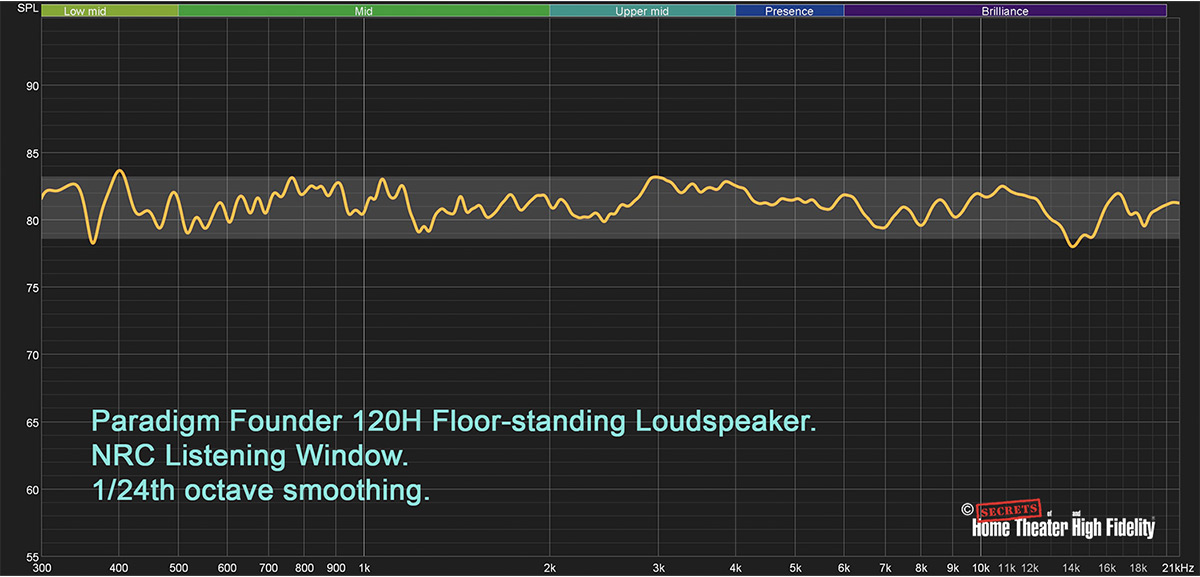
Paradigm Founder 120H, NRC Listening Window Response
This is a plot of the NRC listening window for the Paradigm Founder 120H scaled from 300 Hz on up which is averaged from the following measurements: 0-degree on-axis, +-15 degrees vertical, and +-15 degrees horizontal. In this portion of the frequency range that is dominated by the speaker (response below 300 Hz tends to be dominated by the room and can vary greatly), we see a decently controlled and uniform response through the indicated 5 dB window. You can see indications of the 1kHz – 3kHz depression in this curve that we saw in the in-room curve above.
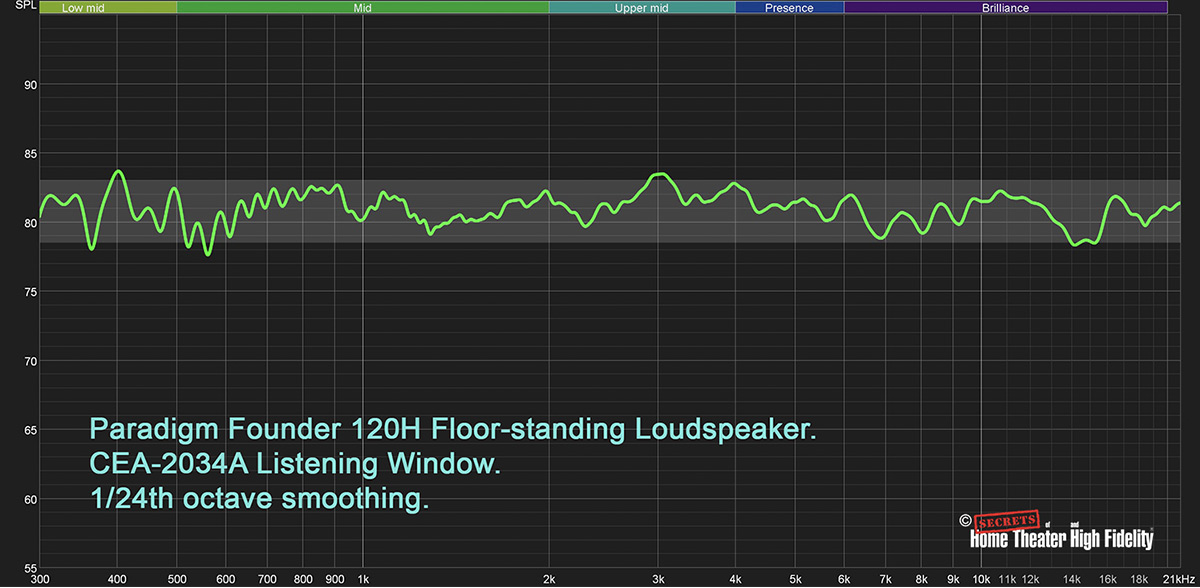
Paradigm Founder 120H, CEA-2034A Listening Window Response
This is a plot of the CEA-2034A listening window for the Paradigm Founder 120H scaled from 300 Hz on up which is averaged from the following measurements: 0-degree on-axis, +-10 degrees vertical, and +-10 and +-20 degrees horizontal. In this portion of the frequency range that is dominated by the speaker (response below 300 Hz tends to be dominated by the room and can vary greatly), again we see a decently controlled and fairly uniform response through the indicated 5 dB window. The depression from 1kHz – 3kHz is less apparent here.
David Rich notes: This looks less correlated in the 1kHz- 3kHz area, which is explained by a sub-optimal vertical radiation pattern. The CEA-2034A uses +/- 10 degrees vertical radiation measurements in producing the average, not the +/-15-degree measurements used in the NRC listening window. The CEA-2034A also has 4 horizontal measurements in the average instead of 2 in the NRC window which washes out some of the vertical deviation.
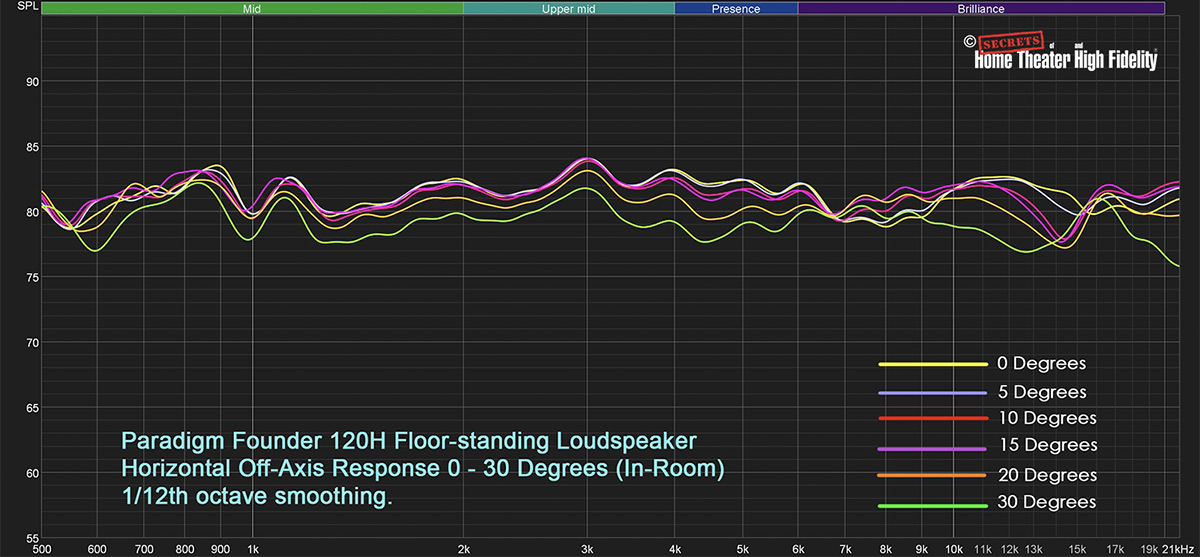
Paradigm Founder 120H, Horizontals 0-30 Degrees
Above are the horizontal radiation curves of the Paradigm Founder 120H from 0 to 30 degrees, scaled from 500 Hz on up. Looking at the angles most closely related to the direct response we see fairly uniform curves with no obvious resonances at the 1/12 octave smoothing used here.
David Rich notes: The curves converge from 6.5kHz – 9kHz which may be a reflection (not a resonance) in the waveguide. Not likely to be audible. A waveguide is a passive acoustic device, and it is impossible for any designer to make it perform ideally.
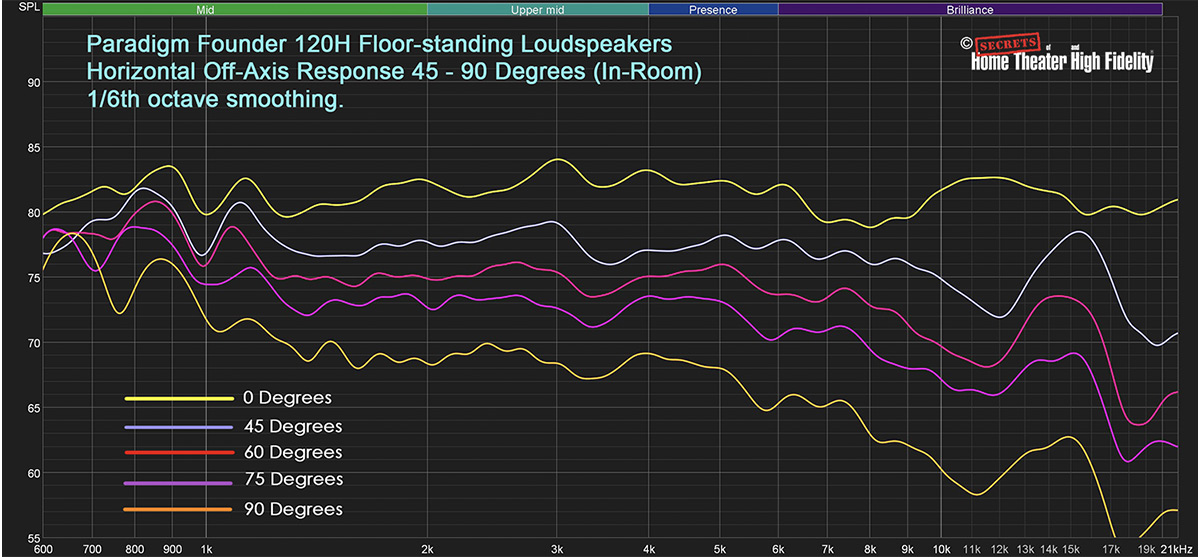
Paradigm Founder 120H, Horizontals 45-90 Degrees
Above are the horizontal radiation curves from 45 to 90 degrees, scaled from 500 Hz on up. Again, we continue to see generally smooth response curves with no obvious resonances and the expected rate of extended off-axis decline.
David Rich notes: This is close to an ideal result. It is not clear what the peak at 15 kHz, which pops up off-axis, is. It is not seen in the on-axis plot which would indicate a resonance. This monotonic radiation pattern with an increasing slope off-axis is reflected in the in-room response above.
Paradigm’s understanding of the need for a smooth monotonic decline of the response with angle goes back more than three decades. As quoted from page 15 of this circa 2000 Paradigm catalog
“The speaker that scored best (in double-blind tests) dispersed sound uniformly – their on and off-axis frequency response curves were smooth and similar”.
It is clear from this literature that the founders that started Paradigm had, as a large part of their mission, to create affordable speakers that realized those theoretical concepts developed at the NRC. Even going so far as building a copy of the NRC anechoic chamber on-site.
As an example, refer to the 1991 Paradigm Studio Monitor. It predates Secrets so I will reference a Stereophile measurement. Look at figure 6 and you will see a graph similar to the above. The company founders created a speaker over three decades old that many would see no reason to upgrade. This is a 3-way speaker made when most NRC affordable designs were limited to two-way. That Paradigm had knowledgeable internal speaker design and production resources is what made this possible. Most other affordable 3rd party speakers in 1990 had wide production tolerances and resonances.
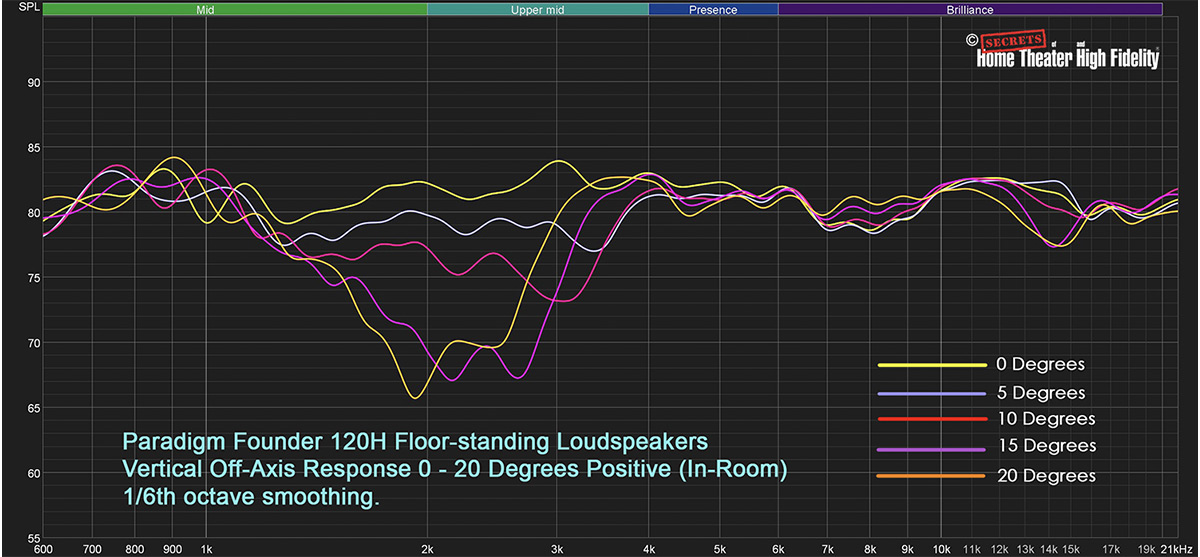
Paradigm Founder 120H, Verticals Positive 0-20 Degrees
Moving to the vertical radiation pattern for positive angles for the Paradigm Founder 120H, we see the plots for 0 to +20 degrees, scaled from 600 Hz on up. Here we see a dip in the response between 2 to 3 kHz going beyond 10 degrees.
David Rich notes: For some reason which I do not understand, the midrange – tweeter crossover deviates from previous designs moving from a 3rd order crossover to a 2nd order and you can see the results here are less than ideal because of it.
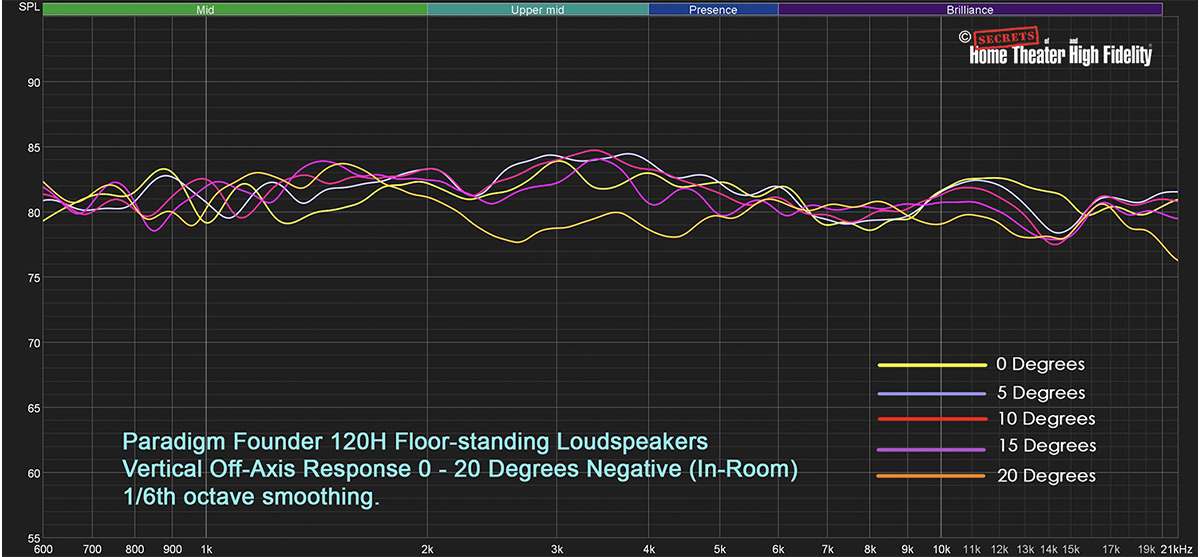
Paradigm Founder 120H, Verticals Negative 0-20 Degrees
In the vertical radiation pattern for negative angles for the Paradigm Founder 120H, we see the plots for 0 to -20 degrees, scaled from 600 Hz on up. Here, the crossover area between the midrange and tweeter shows little change outside of a small 3 kHz dip as we move beyond 15 degrees.
David Rich notes: Given this is a tall speaker it is likely that the listener’s ears will be below the tweeter, so it is not surprising the vertical radiation patterns below the tweeter look better than above which were shown in the last plot.

Paradigm Founder 120H, Impedance Sweep
Here we have the Impedance sweep for the Paradigm Founder 120H. The yellow area of the plot (the area below 300 Hz) indicates where the active electronics control the behavior of the speaker and thus alter the standard impedance results. The dark blue line indicates the impedance while the red trace shows the phase angle relative to that.
David Rich notes: The external power amplifier has no speaker to drive below 300 Hz since the woofers are powered by the internal amplifier. It looks to be a capacitive load with the impedance increasing as the frequency declines. Also, note the negative 90-degree phase angle. One might think a resistor might be used here but the capacitor dissipates no heat. It is unclear if all amps are happy with the pure capacitive load. The impedance hits a 3.5-ohm minimum at 600Hz. At 600Hz the phase has moved to zero degrees. No small disturbances in the impedance are seen which would be an indication of a driver resonance.
The measurements show that the “founders” are back in charge. The Paradigm Founder 120H reflects the latest development in Paradigms more than the 30-year history of bringing NRC research to affordable products.
The PARADIGM FOUNDER 120H is the embodiment of Paradigm at its best. An intelligently designed, high-performance loudspeaker for an approachable price. Bravo!
- Elegant, beautiful aesthetics.
- Effortless sound, top to bottom.
- Excellent imaging.
- Smart design with powerful active bass section and integrated room correction.
- Value. You get a lot of speaker for the money.
- Nothing that comes to mind.
In the final analysis, the Paradigm Founder 120H is an elegant audiophile solution on several levels. If you are not quite ready or sold on the idea of having fully active loudspeakers, the 120H splits a fine hair by taking care of the heavy lifting for you with an active bass section and onboard room correction. That helps remedy the largest problem most people have when setting up speakers, getting a deep, consistent, high-quality bass performance. You are now left with a far easier speaker to drive with your favorite amplifier of choice and that satisfies any lingering “audiophile” tendencies you might have. That’s a bit of a marketing win-win for Paradigm right there. But at the end of the day, it wouldn’t mean anything if the Founder 120H didn’t succeed as a pure high-performance loudspeaker. And it does, in spades! In my time with the Founder 120H it never once failed on delivering an engaging and involving musical performance with a variety of different source material that I lobbed its way. And it consistently did so effortlessly as if it was a far larger set of loudspeakers. Try as I might, I don’t think I was able to get the speakers to lose their composure or even give me an inkling of where their limits might be. It is also a great-looking set of speakers that leverages a lot of technology and know-how to deliver as well as it does. Paradigm has set down a hell of a benchmark for an under-$10,000.00 pair of loudspeakers. Very little comes to mind as comparable to these speakers until you start looking over the $10K fence. I was happy as can be with the sound I was getting from them paired with my Benchmark Media gear and my Raspberry Pi-based streamer. It made for a compact and streamlined system that could be replicated by pairing these speakers with any number of quality integrated amps that we’ve seen pop up these days.
If you are looking to spend a good deal of money on a pair of loudspeakers anytime soon, I would strongly suggest you demo a set of the Paradigm Founder 120H before you do. You may come away with a renewed appreciation of what Scott Bagby and the Paradigm team have brought to the table with these superb speakers. And you might leave the hi-fi shop with a little extra change in your pocket.
You’re welcome.
The author would like to thank David A. Rich for his valuable assistance.


